Factors Blog
Insights Across All Things B2B Account Intelligence & Analytics

Discover Sales-Ready Accounts With Zoho & Webhooks
Target the right accounts, at the right time with intent-based outreach
B2B sales teams spend a lot of time and effort reaching out to cold prospects only to achieve disappointing results. In fact, even successful benchmarks tag the average cold-call response rate at just 2%.
And honestly, It’s not difficult to see why.
While it’s simple enough to find lists of companies and contacts that fit your ideal client profile, it’s a monumental challenge to convince companies to consider your solution when they’re not in the market for one.
So what’s the alternative to reaching out to the right accounts at the wrong time?
Reaching out to the right accounts at the right time of course! Or more specifically, it’s intent-based outreach based on the goldmine of anonymous, sales-ready companies already visiting your website.
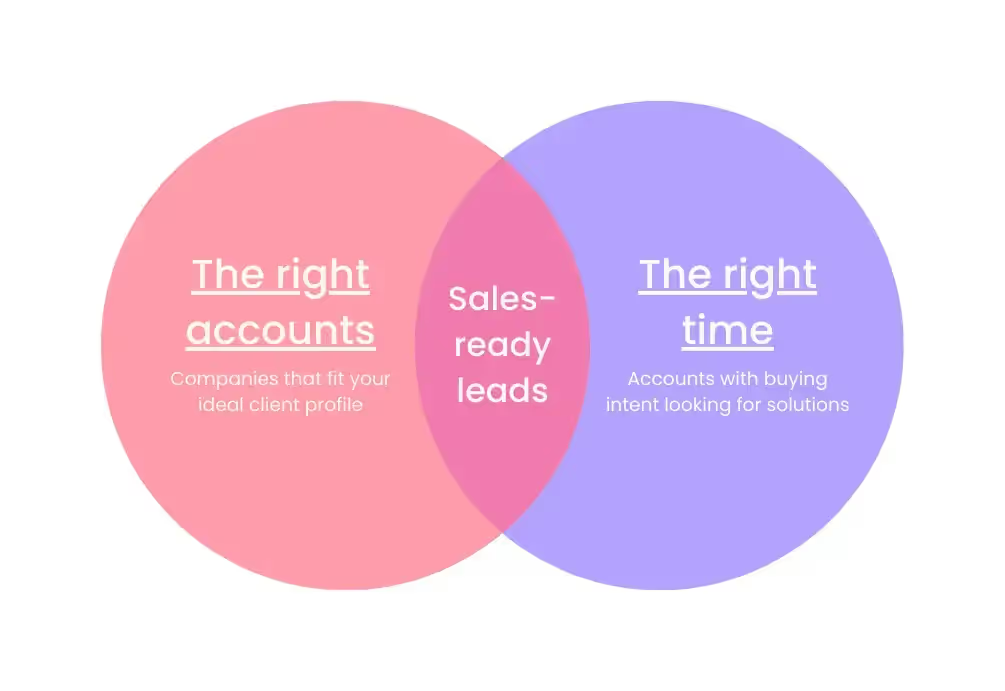
The following guide explores how to identify and target sales-ready accounts with the combined powers of Factors’ account identification and Zoho webhooks. We first discuss how this integration works, before delving into a handful of use-cases.
How It Works: Pushing visitor data back into Zoho
Factors taps into industry-leading IP-lookup technology to identify up to 64% of anonymous account visiting your website. This includes company names as well as firmographics such as geography, industry, employee headcount, revenue range and more.
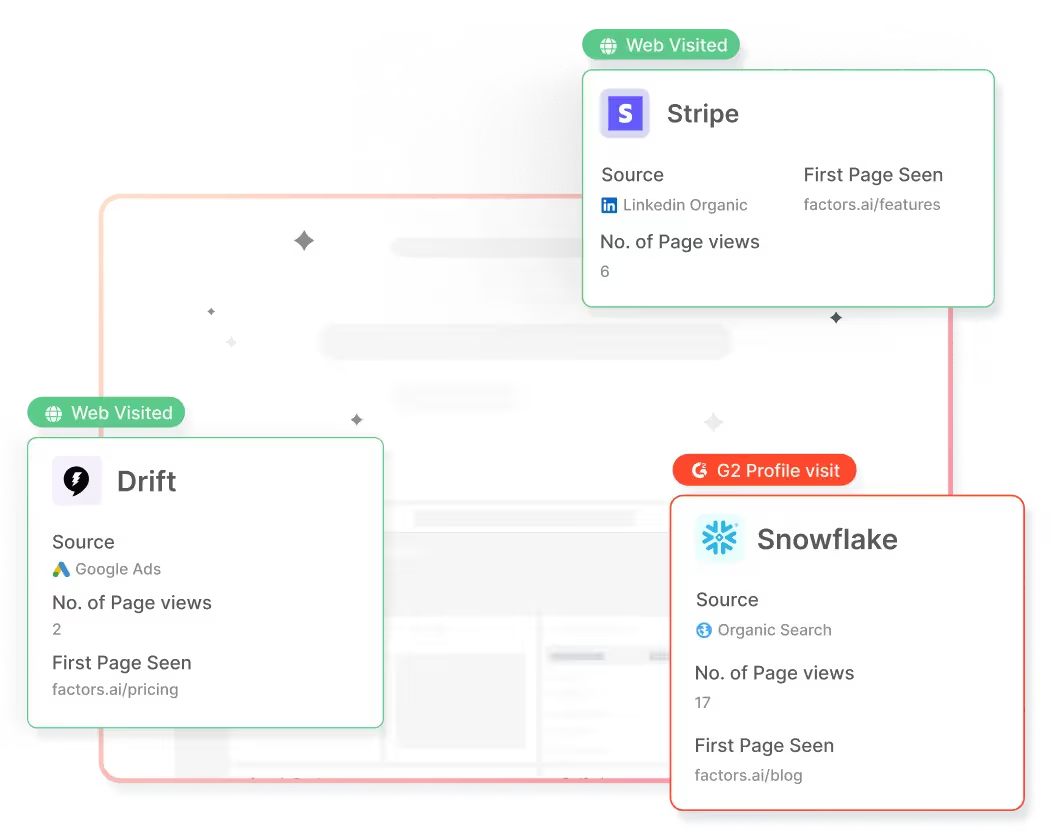
In addition, Factors auto-tracks website activity and engagement at an account level with advanced analytics. This includes page views, button clicks, scroll-depth, account timelines, funnels and more.
With this information, users can filter the total set of anonymous traffic down to ICP accounts that have expressed buying intent:
- ICP criteria: Filter down traffic based on firmographics such as industry, headcount and revenue-range to identify accounts that fit your ideal client profile.
- Intent criteria: Filter down traffic based on intent signals such as high-intent page views such as pricing, time-spent on page, and percentage scroll-depth to identify sales-ready buyers.
In short, access a list of high-intent ICP accounts that are already visiting your website but are yet to submit a form or sign-up.
Now, with webhooks and Zapier, it’s easier than ever to automatically push all this data from Factors into any other tool your team uses. This includes ad platforms, marketing automation platforms, and, in this case, Zoho CRM.
How will this help? Rather than going after cold leads with negligible chances of conversion, sales reps can view, segment, and target sales-ready visitors inside Zoho. As we’ll see in the next section, this dramatically simplifies and improves targeted sales outreach.
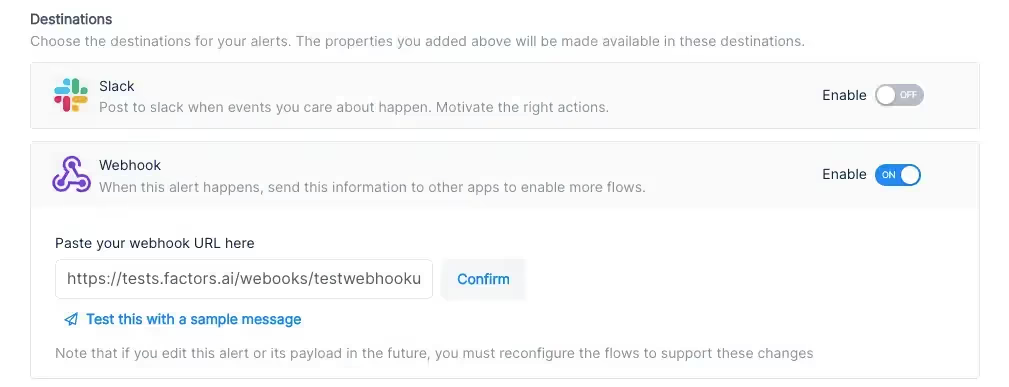
Implementing Webhooks on Factors is easy as pie. See how here.
Use-cases: Making the most of your website visitors
1. Identify new business opportunities
Factors surfaces anonymous, high-intent companies visiting your website — even if they’re yet to submit a contact form. As previously discussed, this data can be filtered down to high-fit, high-intent accounts.
Using webhooks, this data can be pushed from Factors into Zoho. In other words, you can automatically create accounts inside Zoho for companies that match your ICP and intent criteria.
For example, webhooks can be configured to create a new company when a visitor from a US-based software company with at least 250 employees is live on your website.
Here are a few more examples of what you can see inside your CRM with Factors:
- Accounts that visit a landing page through a search ad but fail to submit a form
- Software companies with at least 500 employees visiting high-intent pages like pricing
- US-based companies that have read through at least half a product comparison blog
Rather than relying on the 5% of website traffic that submits a form, teams can identify and target a deep new pool of potential pipeline — all within Zoho. What’s more? Alerts can be relayed to sales reps in real-time through Slack or MS teams so they can immediately reach out to live prospects.
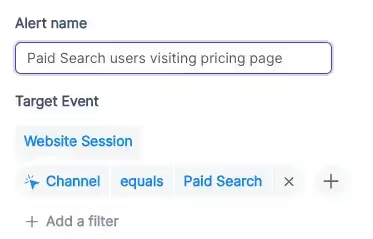
2. Stay on top of existing target accounts
In addition to recording new accounts visiting your website, Factors can be used to monitor and update data for target accounts that already exist within Zoho.
For example, say an account ad clicks on a search ad, submits a demo form, but never schedules time on your calendar. While the account's data is available in Zoho, it can be tedious to track and update their actions post the demo form submission.
To solve for this, Factors can automatically update CRM properties based on trigger criterias when accounts return to your website. Let’s say that the same account is back reading a product alternatives blog or visiting the pricing page after a couple of weeks. This event can be updated within Zoho, including their last active time.
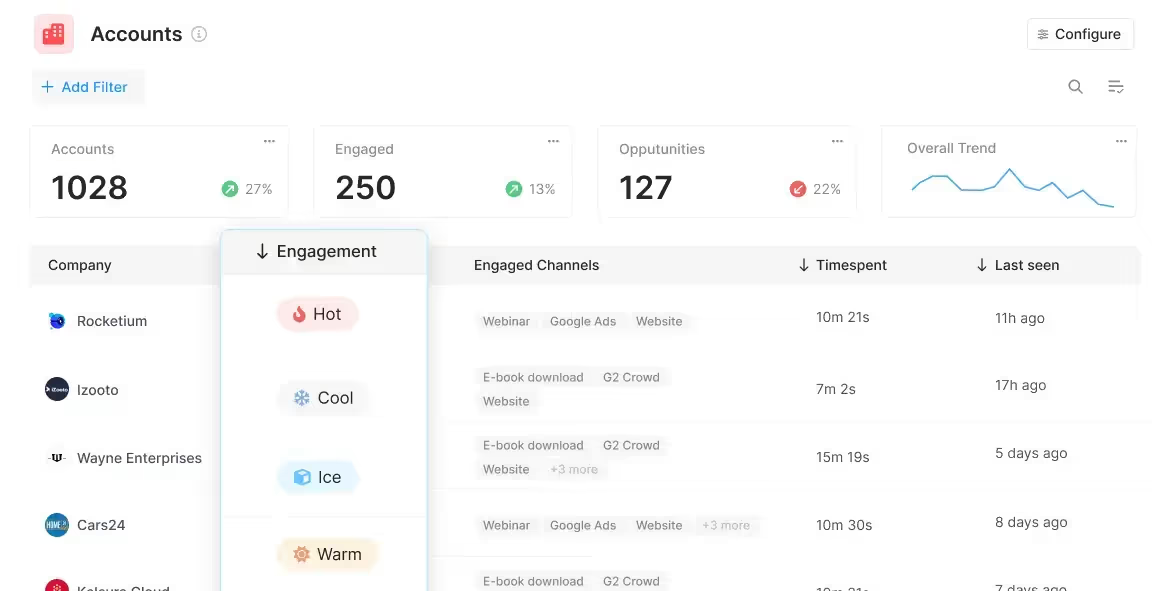
Sales reps can be notified with real-time when high-intent events take place so as to be able to immediately reach out to target accounts and improve the odds of conversion.
3. Accelerate deals with behavioral data
Certain marketing material may or may not be relevant depending on the audience in question. For example, an enterprise-level account may be especially interested in security compliance related content. An early-stage start-up, on the other hand, may find content around cost-effective pricing more appealing.
Factors can track how various types of companies are interacting with your website to understand what target accountscare about most. This data can be pushed back into Zoho so sales reps can easily assess a prospect’s interactions, priorities and pain-points before jumping into a sales call.
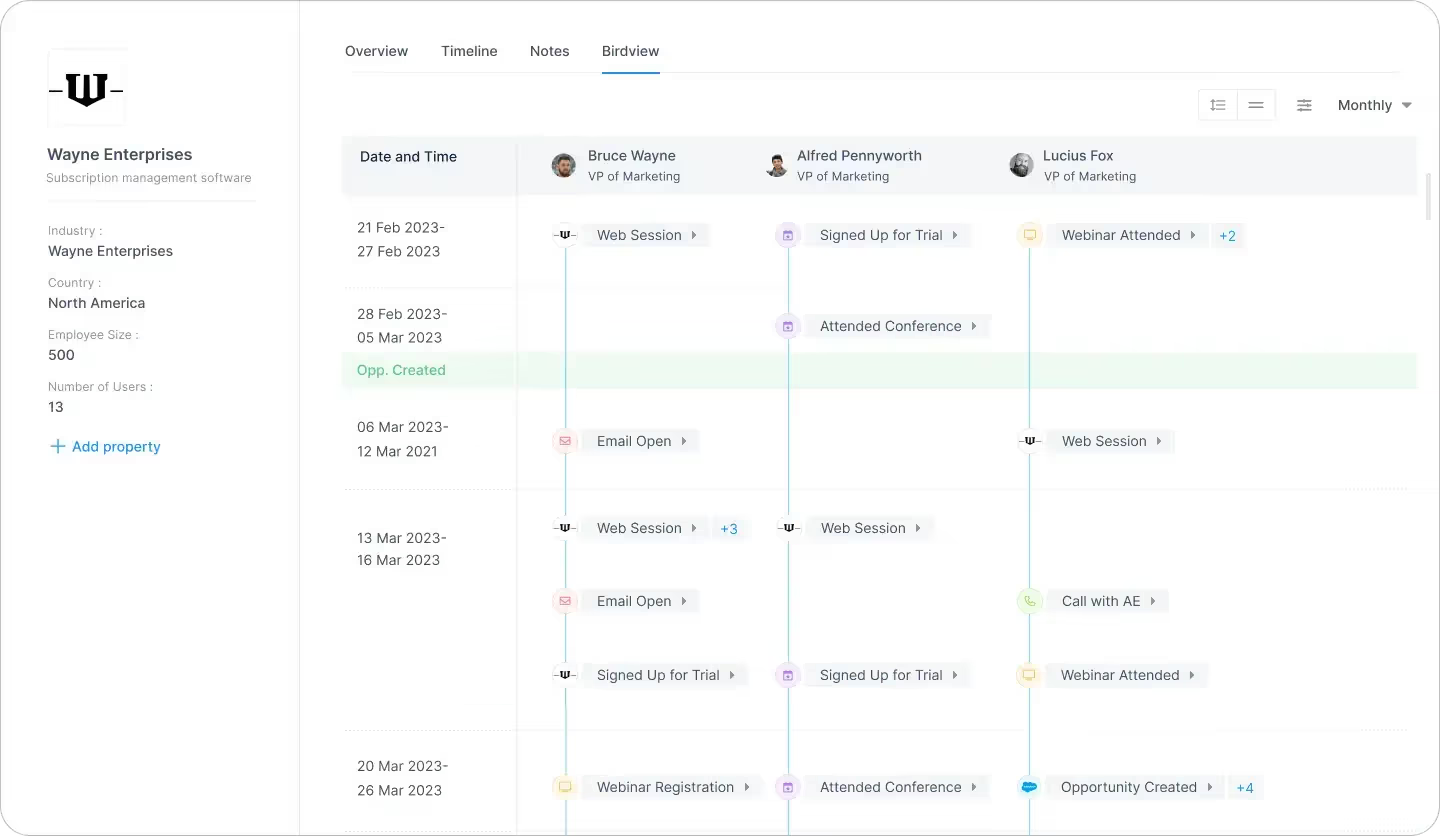
For one, sales reps can accelerate deals by personalizing the customer experience. For another, marketing teams can gauge what resonates best with the target audience and finetune content efforts accordingly.
4. Rekindle lost opportunities
Use Factors to track how accounts that have dropped off the funnel or former customers are returning to engage with your website. For instance, maybe a client who churned a couple of quarters ago is back interacting with a page that highlights a new feature release.
This may be an intent-signal that the account is reconsidering your product. It might be a good idea for sales reps to reach out and share some relevant information on what’s new. Of course, this doesn’t necessarily guarantee a conversion. But it’s far more effective than reaching out to an ice cold prospect.
This guide has covered a handful of ways in which pushing account data back into Zoho can be helpful. Ultimately, the goal is to align account data with relevant stakeholders and technologies in order to:
- Drive intent-based sales outreach
- Refine ABM efforts and spends
- Optimize retargeting campaigns
There are countless other use-cases with account identification working in conjunction with CRMs, MAPs, and more. With webhooks, Factors can push valuable account data to nearly any platform on the planet. How you make the most of that data is really up to you — the possibilities are endless.

Convert High-Intent Accounts With Salesforce & Webhooks
Target the right accounts, at the right time with intent-based outreach
B2B sales teams invest significant time and resources into reaching out to prospects who are yet to show any intention of buying. However, this cold outreach almost always yields disappointing results. Even the most comprehensive benchmarks indicate that the average response to cold-calls is only 2%.
And honestly, It’s not difficult to see why.
While it’s easy enough to find lists of companies and leads that fit your ideal client profile, it’s extremely challenging to convince prospects to consider your solution when they’re not yet ready to buy.
So what’s the alternative to reaching out to the right accounts at the wrong time?
Reaching out to the right accounts at the right time of course! Or more specifically, it’s intent-based outreach based on the pot of gold that is the anonymous, sales-ready companies already visiting your website.

The following guide explores how to identify and convert high-intent accounts with the combined powers of Factors’ accounts identification and Salesforce webhooks. We first discuss how this integration works, before delving into a handful of use-cases.
How It Works: Pushing website data back into Salesforce
Factors taps into industry-leading IP-lookup technology to identify up to 64% of anonymous companies visiting your website — without the need for form submissions. This includes company names as well as firmographics such as geography, industry, employee headcount, revenue range and more.
In addition, Factors auto-tracks website activity and engagement at an accounts level with advanced analytics. This includes page views, button clicks, scroll-depth, account timelines, funnels and more.
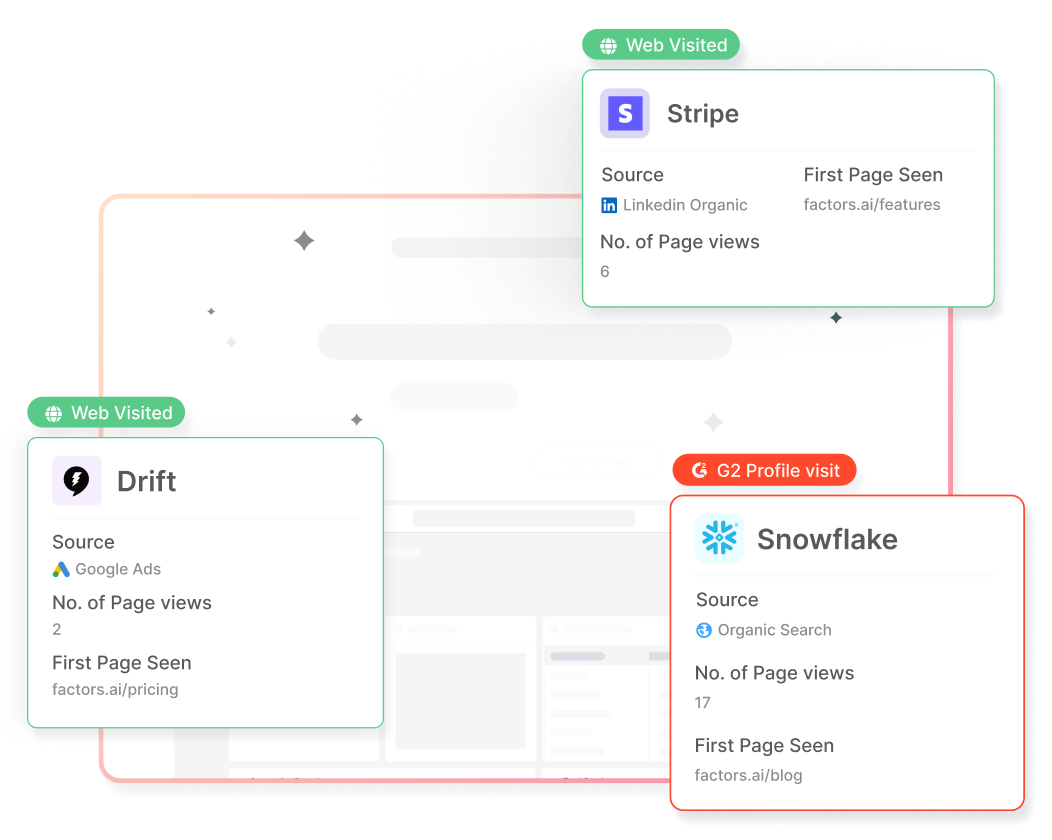
With this information, users can filter the total set of anonymous traffic down to ICP accounts that have expressed buying intent:
- ICP criteria: Filter down traffic based on firmographics such as industry, headcount and revenue-range to identify accounts that fit your ideal client profile.
- Intent criteria: Filter down traffic based on intent signals such as high-intent page views such as pricing, time-spent on page, and percentage scroll-depth to identify sales-ready buyers.
In short, access a list of high-intent ICP accounts that are already visiting your website but are yet to submit a form or sign-up.
Now, with webhooks and Zapier, it’s easier than ever to automatically push all this account data from Factors into any other tool your team uses. This includes ad platforms, marketing automation platforms, and, in this case, Salesforce CRM.
How will this help? Rather than going after cold leads with negligible chances of conversion, sales reps can view, segment, and target sales-ready accounts inside Salesforce. As we’ll see in the next section, this dramatically simplifies and improves targeted sales outreach.
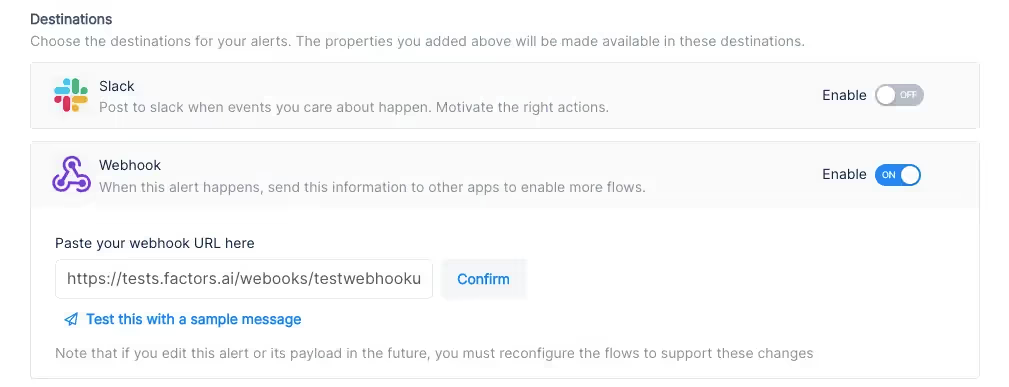
Implementing Webhooks on Factors is easy as pie. See how here.
Use-cases: Making the most of your website traffic
1. Identify new business opportunities
Factors surfaces anonymous, high-intent companies visiting your website. As previously discussed, this data can be filtered down to high-fit, high-intent accounts.
Using webhooks, this data can be pushed from Factors into Salesforce. In other words, you can automatically create accounts inside Salesforce for companies that match your ICP and intent criteria.
For example, webhooks can be configured to create a new account when a visitor from a US-based software company with at least 250 employees is live on your website.
Here are a few more examples of what you can see inside your CRM with Factors:
- Accounts that visit a landing page through a search ad but fail to submit a form
- Software companies with at least 500 employees visiting high-intent pages like pricing
- US-based companies that have read through at least half a product comparison blog
Rather than relying on the 5% of website traffic that submits a form, teams can identify and target a deep new pool of potential pipeline — all within Salesforce. What’s more? Alerts can be relayed to sales reps in real-time through Slack or MS teams so they can immediately reach out to live prospects.
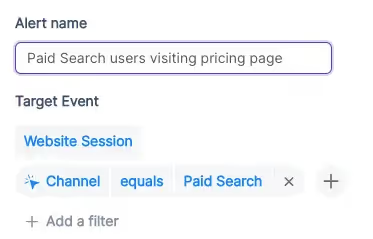
2. Stay on top of existing target accounts
In addition to recording new accounts visiting your website, Factors can be used to monitor and update data for target accounts that already exist within Salesforce.
For example, say an account clicks on a search ad, submits a demo form, but never schedules time on your calendar. While the account's data is available in Salesforce, it can be tedious to track and update their actions post the demo form submission.
To solve for this, Factors can automatically update CRM properties based on trigger criteria when leads return to your website. Let’s say that the same account is back reading a product alternatives blog or visiting the pricing page after a couple of weeks. This event can be updated within Salesforce, including their last active time.
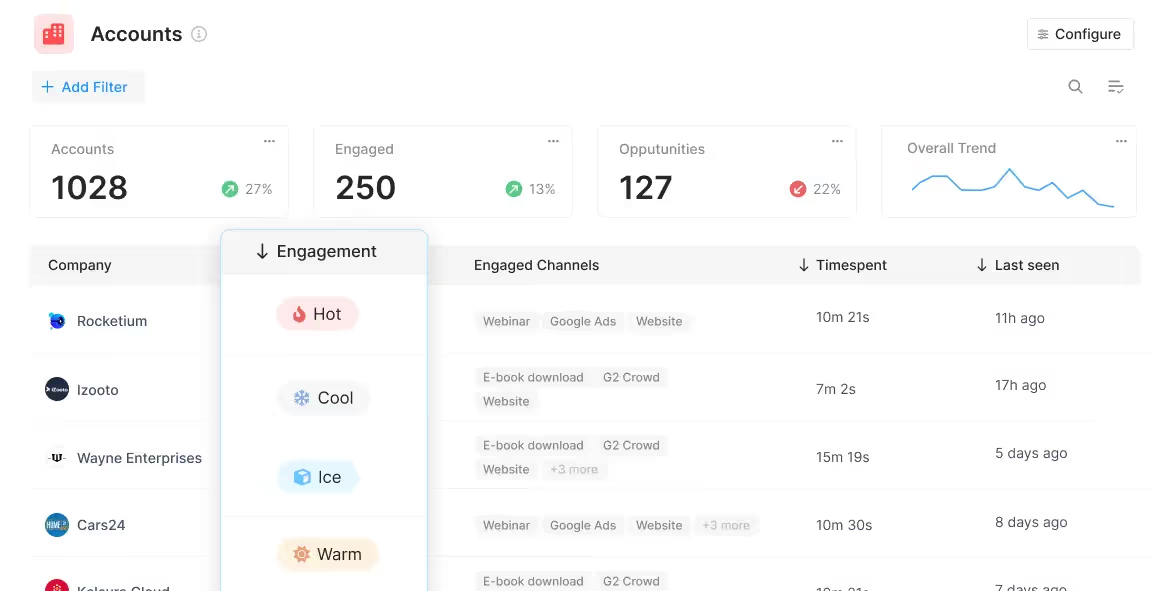
Sales reps can be notified with real-time when high-intent events take place so as to be able to immediately reach out to leads and improve the odds of conversion.
3. Accelerate deals with behavioral data
Certain marketing material may or may not be relevant depending on the audience in question. For example, an enterprise-level account may be especially interested in security compliance related content. An early-stage start-up, on the other hand, may find content around cost-effective pricing more appealing.
Factors can track how various types of companies are interacting with your website to understand what visitors care about most. This data can be pushed back into Salesforce so sales reps can easily assess a prospect’s interactions, priorities and pain-points before jumping into a sales call.
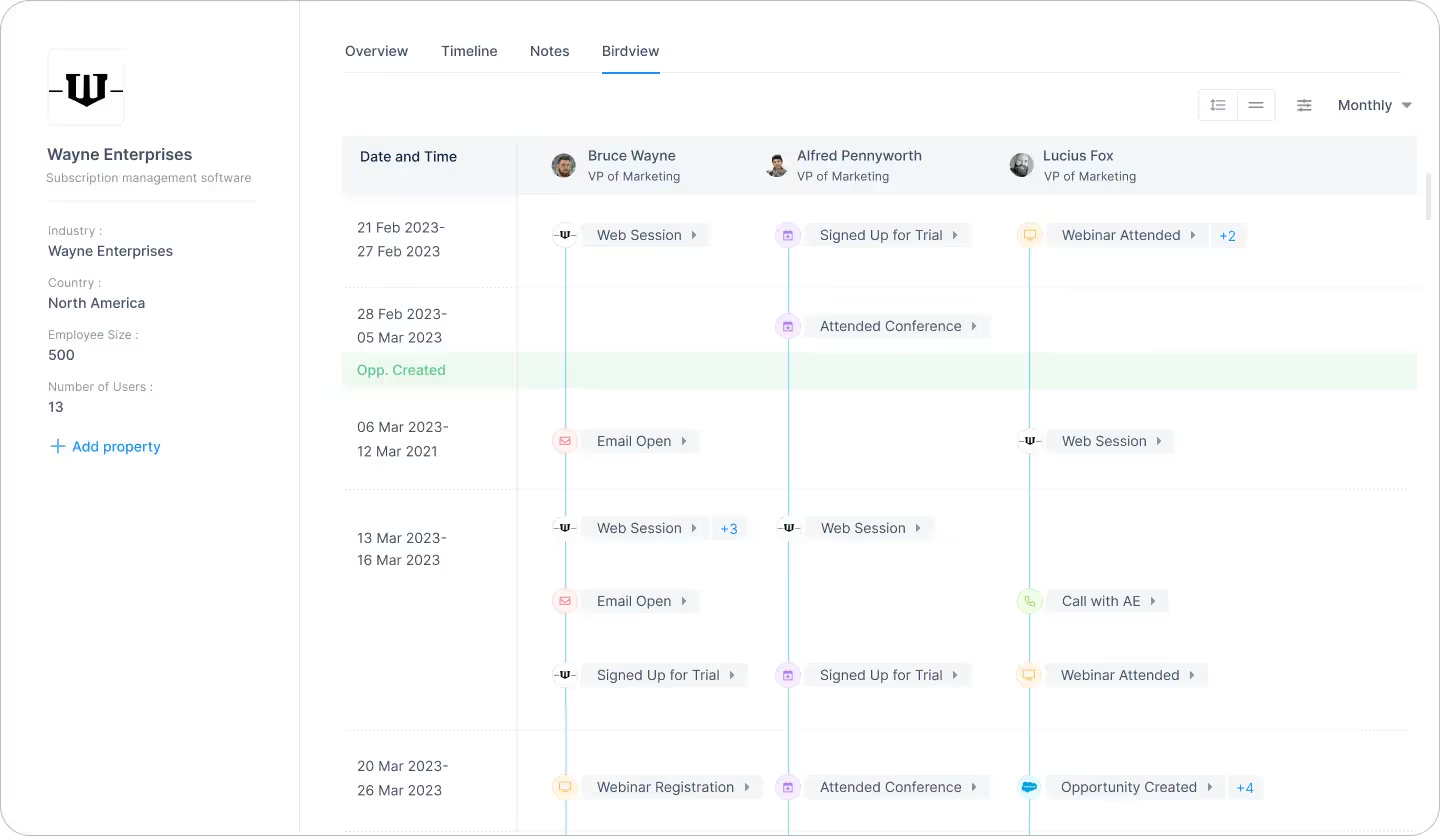
For one, sales reps can accelerate deals by personalizing the customer experience. For another, marketing teams can gauge what resonates best with the target audience and fine-tune content efforts accordingly.
4. Rekindle lost opportunities
Use Factors to track how accounts that have dropped off the funnel or former customers are returning to engage with your website. For instance, maybe an account that churned a couple of quarters ago is back interacting with a page that highlights a new feature release.
This may be an intent-signal that the lead is reconsidering your product. It might be a good idea for sales reps to reach out and share some relevant information on what’s new. Of course, this doesn’t necessarily guarantee a conversion. But it’s far more effective than reaching out to an ice cold lead.
This guide has covered a handful of ways in which pushing account data back into Salesforce can be helpful. Ultimately, the goal is to align visitor data with relevant stakeholders and technologies in order to:
- Drive intent-based sales outreach
- Refine ABM efforts and spends
- Optimize retargeting campaigns
There are countless other use-cases with account identification working in conjunction with CRMs, MAPs, and more. With webhooks, Factors can push valuable account data to nearly any platform on the planet. How you make the most of that data is really up to you — the possibilities are endless.

Identify Sales-Ready Account With Hubspot & Webhooks
Target the right accounts, at the right time with intent-based outreach
B2B sales teams spend a lot of time and effort reaching out to cold prospects only to achieve disappointing results. In fact, even successful benchmarks tag the average cold-call response rate at just 2%.
And honestly, It’s not difficult to see why.
While it’s simple enough to find lists of companies and contacts that fit your ideal client profile, it’s a monumental challenge to convince prospects to consider your solution when they’re not in the market for one.
So what’s the alternative to reaching out to the right accounts at the wrong time?
Reaching out to the right accounts at the right time of course! Or more specifically, it’s intent-based outreach based on the goldmine of anonymous, sales-ready companies already visiting your website.

The following guide explores how to identify and target sales-ready accounts with the combined powers of Factors’ account identification and HubSpot webhooks. We first discuss how this integration works, before delving into a handful of use-cases.
How It Works: Pushing data back into HubSpot
Factors taps into industry-leading IP-lookup technology to identify up to 64% of anonymous companies visiting your website. This includes company names as well as firmographics such as geography, industry, employee headcount, revenue range and more.

In addition, Factors auto-tracks website activity and engagement with advanced analytics. This includes page views, button clicks, scroll-depth, account timelines, funnels and more.
With this information, users can filter the total set of anonymous traffic down to ICP accounts that have expressed buying intent:
- ICP criteria: Filter down traffic based on firmographics such as industry, headcount and revenue-range to identify accounts that fit your ideal client profile.
- Intent criteria: Filter down traffic based on intent signals such as high-intent page views such as pricing, time-spent on page, and percentage scroll-depth to identify sales-ready buyers.
In short, access a list of high-intent ICP accounts that are already visiting your website but are yet to convert.
Now, with webhooks and Zapier, it’s easier than ever to automatically push all this data from Factors into any other tool your team uses. This includes ad platforms, marketing automation platforms, and, in this case, HubSpot CRM.
How will this help? Rather than going after cold prospects with negligible chances of conversion, sales reps can view, segment, and target sales-ready accounts inside HubSpot. As we’ll see in the next section, this dramatically simplifies and improves targeted sales outreach.

Implementing Webhooks on Factors is easy as pie. See how here.
Use-cases: Making the most of your website traffic
1. Identify new business opportunities
Factors surfaces anonymous, high-intent companies visiting your website. As previously discussed, this data can be filtered down to high-fit, high-intent accounts.
Using webhooks, this data can be pushed from Factors into HubSpot. In other words, you can automatically create companies inside HubSpot for visiting companies that match your ICP and intent criteria.
For example, webhooks can be configured to create a new company when a visitor from a US-based software company with at least 250 employees is live on your website.
Here are a few more examples of what you can see inside your CRM with Factors:
- Accounts that visit a landing page through a search ad but fail to submit a form
- Software companies with at least 500 employees visiting high-intent pages like pricing
- US-based companies that have read through at least half a product comparison blog
Rather than relying on the 5% of website traffic that submits a form, teams can identify and target a deep new pool of potential pipeline — all within HubSpot. What’s more? Alerts can be relayed to sales reps in real-time through Slack or MS teams so they can immediately reach out to live prospects.

2. Stay on top of existing target accounts
In addition to recording new accounts visiting your website, Factors can be used to monitor and update data for target accounts that already exist within HubSpot.
For example, say an accounts clicks on a search ad, submits a demo form, but never schedules time on your calendar. While account's data is available in HubSpot, it can be tedious to track and update their actions post the demo form submission.
To solve for this, Factors can automatically update CRM properties based on trigger criterias when accounts return to your website. Let’s say that the same account is back reading a product alternatives blog or visiting the pricing page after a couple of weeks. This event can be updated within HubSpot, including their last active time.

Sales reps can be notified with real-time when high-intent events take place so as to be able to immediately reach out to accounts and improve the odds of conversion.
3. Accelerate deals with behavioral data
Certain marketing material may or may not be relevant depending on the audience in question. For example, an enterprise-level account may be especially interested in security compliance related content. An early-stage start-up, on the other hand, may find content around cost-effective pricing more appealing.
Factors can track how various types of companies are interacting with your website to understand what target accounts care about most. This data can be pushed back into HubSpot so sales reps can easily assess a prospect’s interactions, priorities and pain-points before jumping into a sales call.

For one, sales reps can accelerate deals by personalizing the customer experience. For another, marketing teams can gauge what resonates best with the target audience and finetune content efforts accordingly.
4. Rekindle lost opportunities
Use Factors to track how prospects who have dropped off the funnel or former customers are returning to engage with your website. For instance, maybe an account that churned a couple of quarters ago is back interacting with a page that highlights a new feature release.
This may be an intent-signal that the account is reconsidering your product. It might be a good idea for sales reps to reach out and share some relevant information on what’s new. Of course, this doesn’t necessarily guarantee a conversion. But it’s far more effective than reaching out to an ice cold prospects.
This guide has covered a handful of ways in which pushing account data back into HubSpot can be helpful. Ultimately, the goal is to align account data with relevant stakeholders and technologies in order to:
- Drive intent-based sales outreach
- Refine ABM efforts and spends
- Optimize retargeting campaigns
There are countless other use-cases with account identification working in conjunction with CRMs, MAPs, and more. With webhooks, Factors can push valuable account data to nearly any platform on the planet. How you make the most of that data is really up to you — the possibilities are endless.
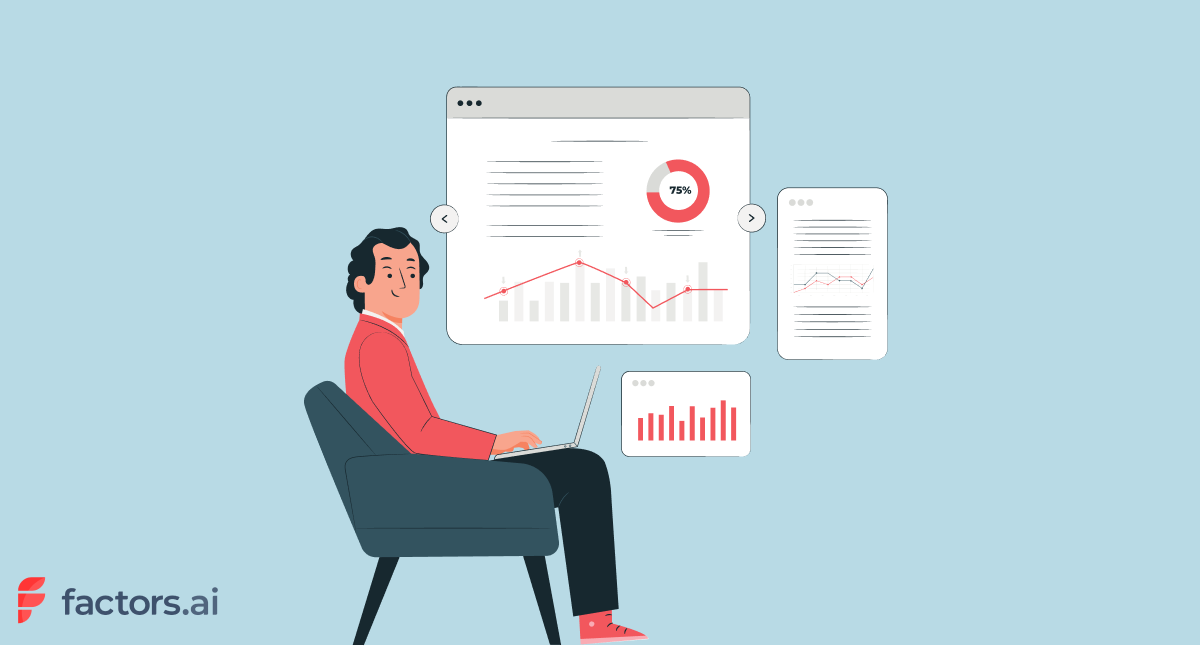
7 Benefits Of Marketing Analytics For Customer Experience
Mastering marketing analytics is key to any business that wants to become a brand.
Today, 73% of customers find user experience to be the most critical factor in making a purchase decision. And to give customers that experience, analytics is your ultimate weapon.
But can a business curate an experience worth remembering without any insight into its customers? The answer is a big NO.
Marketing and customer analytics provide valuable insights into customer behavior.
Let us understand why with these 7 Benefits of Marketing Analytics for Customer Experience.
7 Benefits of Marketing Analytics For Customer Experience
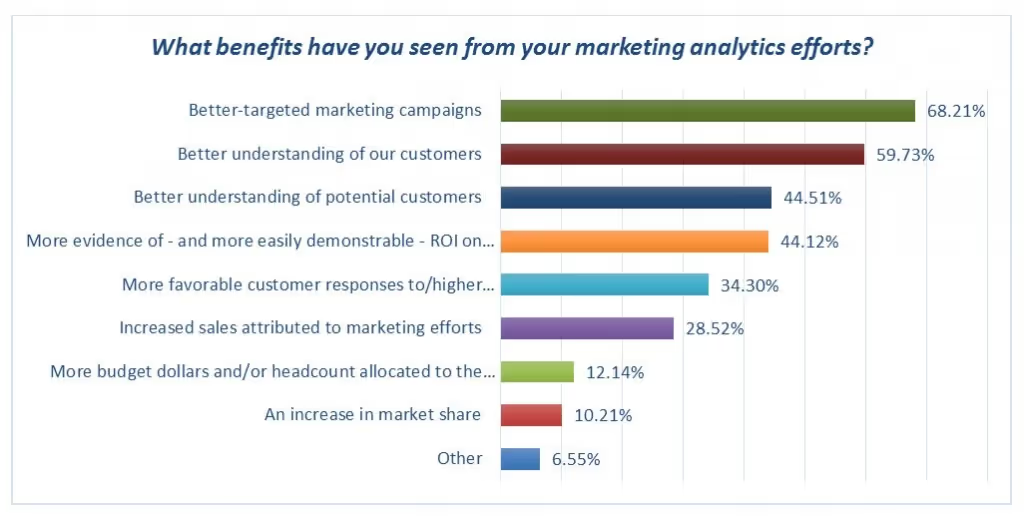
1. Better Customer Engagement
Marketing analytics is a reflection of customer behavior. If a customer likes what they see—they are more likely to engage. If they don’t, they’ll bounce off.
By analyzing customer data, teams can gain a deeper understanding of customer pain-points and preferences.
For example, enterprise level customers may be more interested in privacy-compliance while material around cost-effective plans may appeal more to smaller teams.
One can further gauge these preferences by testing hypotheses and running A/B tests.
Armed with this information, one aligns their sales and marketing team to create more targeted and effective marketing campaigns for a business, tailored specifically to the targeted customers and enterprises.
This personalisation is the benefits of marketing analytics, hence helping a brand become trustworthy and more valuable.
2. Reducing Churn Rate
Let’s understand Churn with an example. If 1000 visitors signed up for your services, but 50 of those stop doing business with you, your business has a Churn rate of 5%.
The churn rate is the percentage of customers who stop doing business.
By analyzing customer data, you can identify the factors that are causing customers to leave. This can be attributed to poor customer support, limited progress in the product road map, cost issues, or better alternatives being available in the market.
Whatever the case, marketing analytics helps pin-point where customers are coming from, and why they're leaving. Additionally, you can use this data to retarget your customers with the right message to regain them.
And because they already know about you, the conversion rate will be much higher and you’ll be able to earn loyal customers with minimum effort.
To do so, your business can identify common pain points—by monitoring customer feedback—and take proactive steps to gain benefits of marketing analytics for customer experience.
3. Increased Lifetime Value

For any business, Customer Lifetime Value is one of the most important metrics. CLV is a metric that represents the total net value a customer brings to a business over the duration of their relationship.
And one of the many benefits of marketing analytics is, you can put systems in place that extend your customer loyalty.
One of the best examples of this insight in practice is Amazon Prime.
This loyalty program was started back in 2005 and has been one of the most important parts of the business today.
It has been reported that Prime customers spend $1400 per year on products, whereas non-Prime customers spend just $600 on average.
If a customer is likely to stay with the brand and make higher purchases—they surely are adding a lot more value. Hence helping businesses gain benefits of marketing analytics.
Additionally, since they are sticking with your brand, you don’t have to spend a lot on customer acquisition as well. Less spending and more earning equals better business.
4. Increased Customer Loyalty
Why do businesses offer discounts? Or create ungated content?
The answer to both these questions—and many more—is to gain customer loyalty.
It is one of the most important brand assets, which in today’s world holds a lot of value. This can be seen with brands like Supreme, Apple, and Coca-Cola.
Each one of such brands has developed a customer loyalty unique to their brand. They have gained benefits of marketing analytics for building brand experience.
It has not just happened on its own. All this has been a clear benefit of marketing analytics. Brands have used the tracked customer data using CRMs tools like ActiveCampaign and ActiveCampaign alternative to create unique experiences.
They use it to create ads, target customers, create UI, write email and form an overall experience for their customers. All that is to ensure, there are no leaks in the funnel.
5. Improved Customer Journey
In this whole list of the benefits of marketing analytics, we have talked about customer experience a lot.
But what will you see in your analytics exactly? You’ll see your customer journey.
You’ll see how a customer learns about your product, comes to your website, goes to the pricing page, and eventually signs up.
But what if you see that many customers who are visiting your pricing page are not signing up?
Your Customers might not send you a message about this, but they clearly are not seeing the right “value for money” proportion.
At this point, what you can try is—to improve your pricing page. This can be done by adding reviews, stats, small case studies, or examples on this page.
You’ll only be able to know how to improve customer journeys by tracking Marketing analytics and understanding what’s holding them back. And this understanding is one the main benefits of marketing analytics for customer experience.
Once all the friction is removed, the journey from social media engagement to sign-up would be much smoother and quicker.
6. Improved Customer Support
Customer support is a very important part of creating an effective experience for your customers.
It helps users be sure that your business is reliable and will help them solve any problem they might face.
But here’s a thing that you might not know. 86% of customers prefer to solve their problems on their own, rather than contacting customer support.
Leveraging social media channels like Instagram and Facebook, or WhatsApp for customer service, can offer efficient self-service options and quick responses, aligning with this customer preference.
If you are seeing a lot of “How-to’s” with your product—what your customer needs is a class on how to use your product effectively.
For this, you can use public platforms like Youtube, Vimeo etc. But if you are going to have a different class and session you might need tools like Teachable or Teachable alternatives for your business.
One of the core benefits of marketing analytics will only be uncovered once you start to understand the hurdles your customers are facing, and how to eliminate them.
7. Increased Referrals
Referrals are the result of having the best customer experience. If someone is recommending your service or product to someone else, that means they have trust in your brand.
And your business has gained this trust and this customer experience is understanding the benefits of marketing analytics.
Right from the social media post you shared to the pricing page you optimized—Marketing analytics have been your stepping stone.
And if you are not using this data, I am sure your business has a lot more potential than you think.
Key takeaways
For any entrepreneur that is looking to grow their business, and become a well-known brand among customers—the benefits of marketing analytics are limitless.
We all are aware of the story when Jeff Besoz updated the Amazon hardware page to make it easy for customers to buy the right screws.
All that was because of feedback he got from the customer. Now for most businesses, a customer might not even know what exactly will help them.
But if you can deliver something that matches their expectation of the experience—you and your business are on the right path of growth.
About the author
Divya is a marketer, nature lover & startup enthusiast. Founder of Unifiedist. She has an immaculate experience in GTM strategy & SEO. She always follows her instinct and travels with her Ikigai.

LinkedIn Intent Data: The Missing Ingredient in Your B2B Sales Strategy?
LinkedIn Intent Data: The Missing Ingredient in Your B2B Sales Strategy?
With over 900 million members across 200 countries and 4 out of 5 members driving business decisions, LinkedIn is a crucial platform for B2B sales and marketing teams. 97% of B2B marketers use LinkedIn for lead generation. But how can you ensure that your LinkedIn ads and marketing efforts are influencing conversions?
Enter LinkedIn intent data.
LinkedIn intent data shows if a prospect has interacted with or shown interest in your LinkedIn ads, allowing you to gauge their likelihood of converting. In this article, we'll discuss how this data can benefit both marketing and sales teams, and how Factors can help you make the most of this valuable information.
TL;DR
- LinkedIn intent data reveal prospects' level of interest and engagement with ads.
- It helps illuminate the "dark funnel" of hidden interactions and potential leads.
- Benefits include audience segmentation, ad optimization, retargeting, and lead scoring.
- Marketers can use intent data to optimize campaigns and improve targeting.
- Sales teams can use intent data to prioritize high-intent accounts and personalize outreach.
- Factors is a tool that integrates LinkedIn intent data with CRM data for deeper insights.
What Is LinkedIn Intent Data?
LinkedIn intent data is a crucial piece of information that reveals the level of interest and engagement prospects have with your LinkedIn ads. By analyzing this data, you can gain valuable insights into the buyer's journey and identify potential leads who are more likely to convert.
This information is vital in today's competitive B2B landscape, where understanding the preferences and needs of your target audience can significantly improve your sales and marketing efforts.
Why Is LinkedIn Intent Data Important?
In B2B, the buyer's journey is often complex and multifaceted. Prospects interact with various touchpoints before making a purchase decision. Unfortunately, not all of these interactions are visible or easily tracked, leading to the existence of a "dark funnel."
What is the dark funnel?
The dark funnel is part of the buyer's journey where prospects have been exposed to your LinkedIn ads, content, or other marketing materials but haven't directly engaged with them or converted immediately.
These “hidden” interactions can make it challenging to assess the true impact of your marketing efforts and identify valuable leads who may convert later in their journey.
How does Linkedin intent data help?
LinkedIn intent data illuminates the dark funnel by providing insights into prospects' level of interest and engagement with your ads, even if they haven't directly interacted with them. Here are a few ways in which it can help you gain a deeper understanding of the dark funnel:
- Segment your audience based on their intent data: By analyzing LinkedIn intent data, you can segment your audience into different categories based on their level of engagement and interest in your ads. This will help you create tailored account-based marketing campaigns that address the unique needs and preferences of each segment, increasing the chances of converting these prospects. For instance, if you run an e-learning platform, you can segment users who have engaged with your ads about coding courses and target them differently than users who’ve shown interest in a writing course.
- Optimize your ad creatives and targeting: Understanding the preferences of prospects within the dark funnel can help you optimize your LinkedIn ad creatives and targeting strategies to better resonate with your audience. Then, fine-tuning your ads based on intent data insights can improve the overall effectiveness of your marketing efforts. For example, if you find that prospects in the dark funnel are engaging more with video ads than image-based ads, you can allocate more budget to video ad campaigns and optimize targeting to reach more people likely to be interested in your product.
- Retarget potential leads: With this data at hand, you can retarget prospects with tailored content and offers. If a prospect has engaged with content about a particular product or service on your website, but didn't complete a purchase, you can retarget them with a special discount or offer, encouraging them to revisit your site and complete the transaction.
- Enhance lead scoring and prioritization: By incorporating intent data, you may find that a group of people have engaged heavily with your ads and content, but haven't reached out directly yet. For instance, if you're a B2B software company, your sales team can reach out to prospects who've shown a high level of engagement with specific features of the software. They can demo the tool while keeping the focus of the conversation on the feature of interest.
LinkedIn Intent Data For Marketers: Unlock The Potential Of Your Ads
As marketers, we aim to reach the right audience, deliver a message that resonates with them, and ultimately drive conversions. Linkedin buyer intent data is highly valuable in achieving these objectives and gaining valuable insights into audience engagement. With this, you can optimize your LinkedIn marketing strategy in several ways:
- Know if ads are reaching the intended audience: Linkedin’s intent data gives you insights into who is interacting with your ads. This information is then curated in an account-level format so your ABM teams can filter accounts with the highest interest in buying your product or service.
- Optimize LinkedIn ads based on engagement: Analyzing LinkedIn intent data can tell which ad formats, visuals, and copy resonate most with your audience. You can then make data-driven decisions to optimize your ads, boosting engagement and conversion rates.
- Know which kind of ad copy resonates with the audience: By examining the intent data from different ad variations, you can identify the messaging that best captures your audience's attention. This empowers you to tailor your ad copy and creatives to better appeal to your target audience, leading to more clicks, higher engagement, and ultimately, more conversions.
- Combine LinkedIn intent data with third-party intent data for a holistic approach: By integrating this data with third-party intent data (from sources like G2, TrustRadius, etc.), you can create a more comprehensive understanding of your prospects' needs throughout their buying journey. This enables you to deliver targeted, relevant content and ads that address their pain points and move them closer to conversion.
How To Use LinkedIn Buyer Intent To Improve Pipeline Velocity
Pipeline velocity is a key performance indicator (KPI) for sales teams, as it measures the speed at which leads move through the sales funnel and ultimately convert into customers. Leveraging LinkedIn buyer intent data can significantly improve pipeline velocity by helping you prioritize high-intent accounts, personalize outreach, and align sales and marketing efforts. Here's how:
- Prioritize high-intent accounts for account-based marketing (ABM): LinkedIn buyer intent data can help sales and account-based marketing (ABM) teams identify high-intent accounts, those that have shown significant interest in your LinkedIn ads, and are more likely to convert into customers. By prioritizing these high-intent accounts, your team can focus its efforts on the most promising leads, increasing the chances of closing deals and improving overall pipeline velocity.
- Use intent data and deanonymization to personalize outreach: Using LinkedIn buyer intent data, you can tailor your sales outreach to the specific needs and interests of your prospects. Adding Factors to the mix, you can also deanonymize website traffic and know about the company and industry that they work in. With this, you can gain deeper insights into their pain points, preferences, and points of friction. This allows your sales team to craft personalized messages that address these concerns and demonstrate the value of your product or service, helping to move prospects through the sales funnel more quickly.
- Align sales and marketing based on intent data: Regularly analyzing LinkedIn buyer intent data can help you identify trends and patterns in your prospects' behavior, allowing you to optimize your sales and marketing tactics accordingly. This is also good for reporting on the effectiveness of campaigns. For example, you may discover that certain types of content or ad formats resonate better with your target audience, leading to higher engagement and faster movement through the sales funnel.
- Add intent data into CRM and marketing automation platforms: Integrating LinkedIn buyer intent data into your CRM and marketing automation platforms can help automate lead scoring, segmentation, and nurturing efforts based on prospects' engagement and intent. This allows your sales and marketing teams to efficiently focus their efforts on high-intent leads, ultimately improving pipeline velocity.
- Enhance Account Scoring: Incorporating LinkedIn buyer intent data into your account scoring methodology can provide a more accurate assessment of a prospect's likelihood to convert. The combination of data from multiple sources allows your sales and marketing teams to better score leads. Add to that Factors’ account scoring features, and you can automate your prioritization process for the teams too.
Make The Most Of Your LinkedIn Intent Data with Factors
Leveraging buyer intent data from LinkedIn effectively can help you identify the users with the highest interest and modify your approach to better target the accounts. Factors enables you to maximize the potential of this data to drive results. Here's how:
1. Integrated data analysis
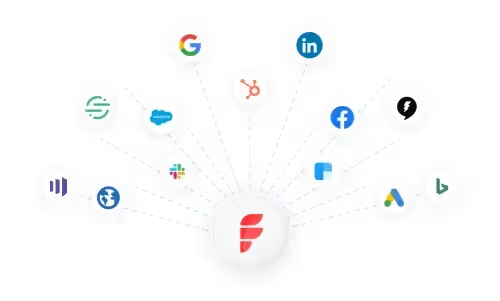
Factors helps combine Linkedin intent data with data from other sources, such as CRM platforms, ads, website, and more. This integrated approach enables you to gain a holistic understanding of your prospects' buyer journey, helping you identify high-intent accounts and optimize your marketing and sales strategies accordingly.
2. Visual user timelines for enhanced attribution

Factors offers a visual user timeline that lets you track and analyze your prospects' interactions with your LinkedIn ads over time. You can also view if the same user has interacted with your brand over other platforms or campaigns that you already track. This gives you a holistic view of an individual user's journey and engagement with your brand across multiple touchpoints.
3. Account intelligence
Factors' account intelligence capability allows users to identify anonymous companies visiting your website, along with their intent and firmographics. Your ABM teams can then personalize outreach by understanding their interactions with your content and ads to improve conversions.

4. Optimize ad engagement and performance
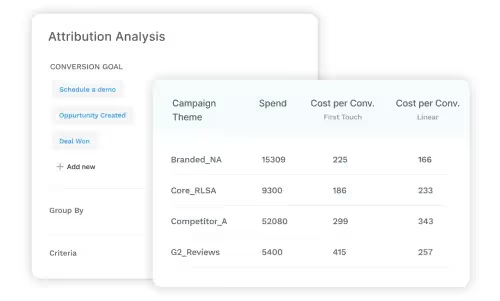
Factors uses Linkedin ad engagement data and audience insights to help you optimize your Linkedin ad campaigns. Knowing which ads resonate with your target audience and generate the most engagement can help you refine your campaigns to maximize returns and drive conversions. You can also uncover the ad formats, content types, and messaging that resonate best with your target audience and increase the likelihood of conversions.
5. Account scoring
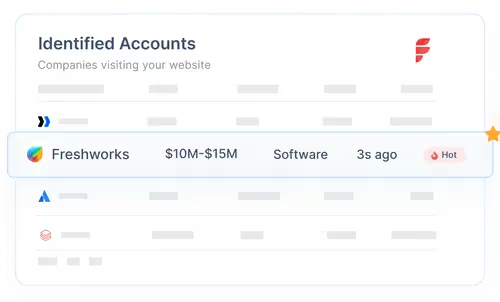
Factors' account scoring feature helps prioritize prospects based on their engagement and intent, enabling sales teams to focus their efforts on high-value targets. By combining intent data with firmographics, technographics, and engagement history, you can create a comprehensive account score that helps your sales team prioritize their efforts and focus on the most promising opportunities.
FAQs
1. How does LinkedIn calculate buyer intent?
LinkedIn calculates buyer intent by analyzing user engagement with your company's ads, content, and other interactions on the platform. This includes factors such as clicks, likes, comments, shares, and time spent viewing your content. By tracking these interactions, LinkedIn can identify which users are genuinely interested in your products or services, signaling potential buyer intent.
2. How can you use intent data for sales?
Intent data can be used by sales teams to prioritize high-intent accounts, personalize outreach efforts, align sales and marketing initiatives, optimize sales tactics, and enhance account scoring. By leveraging intent data, sales teams can focus their resources on the most promising leads, creating more targeted and effective sales strategies that drive revenue growth and improve pipeline velocity.
Bring the Power of LinkedIn Buyer Intent Data to B2B Sales
Leveraging LinkedIn buyer intent data can revolutionize your sales and marketing efforts, enabling you to prioritize high-intent accounts, personalize outreach, and align your teams for maximum impact.
By using powerful tools like Factors, you can gain a comprehensive view of buyer journeys and make data-driven decisions to boost pipeline velocity and drive revenue growth. Don't miss out on valuable opportunities – uncover the potential of LinkedIn buyer intent data and elevate your B2B sales strategy today.

Account-Based Marketing Team Structure: Key Roles and Responsibilities to Drive Success
Account-based marketing (ABM) is unlike traditional marketing. Instead of trying to reach the masses, you focus on a small set of high-value accounts.
The ABM team crafts individually tailored content, advertisements, and emails for the target accounts, increasing the likelihood of conversion. For instance, consider a company that sells cybersecurity solutions to financial institutions. The target accounts are large banks and credit unions looking to upgrade their cybersecurity measures.
The ABM team creates tailored content such as case studies, whitepapers, and infographics. They also design advertisements highlighting the revenue losses from security breaches. All the content is tailor specifically for the financial industry, and sometimes even for specific companies.
This targeted approach makes ABM a powerful strategy. Businesses that used ABM strategies saw revenue growth of 208% and an average increase of 171% in their annual contract values.
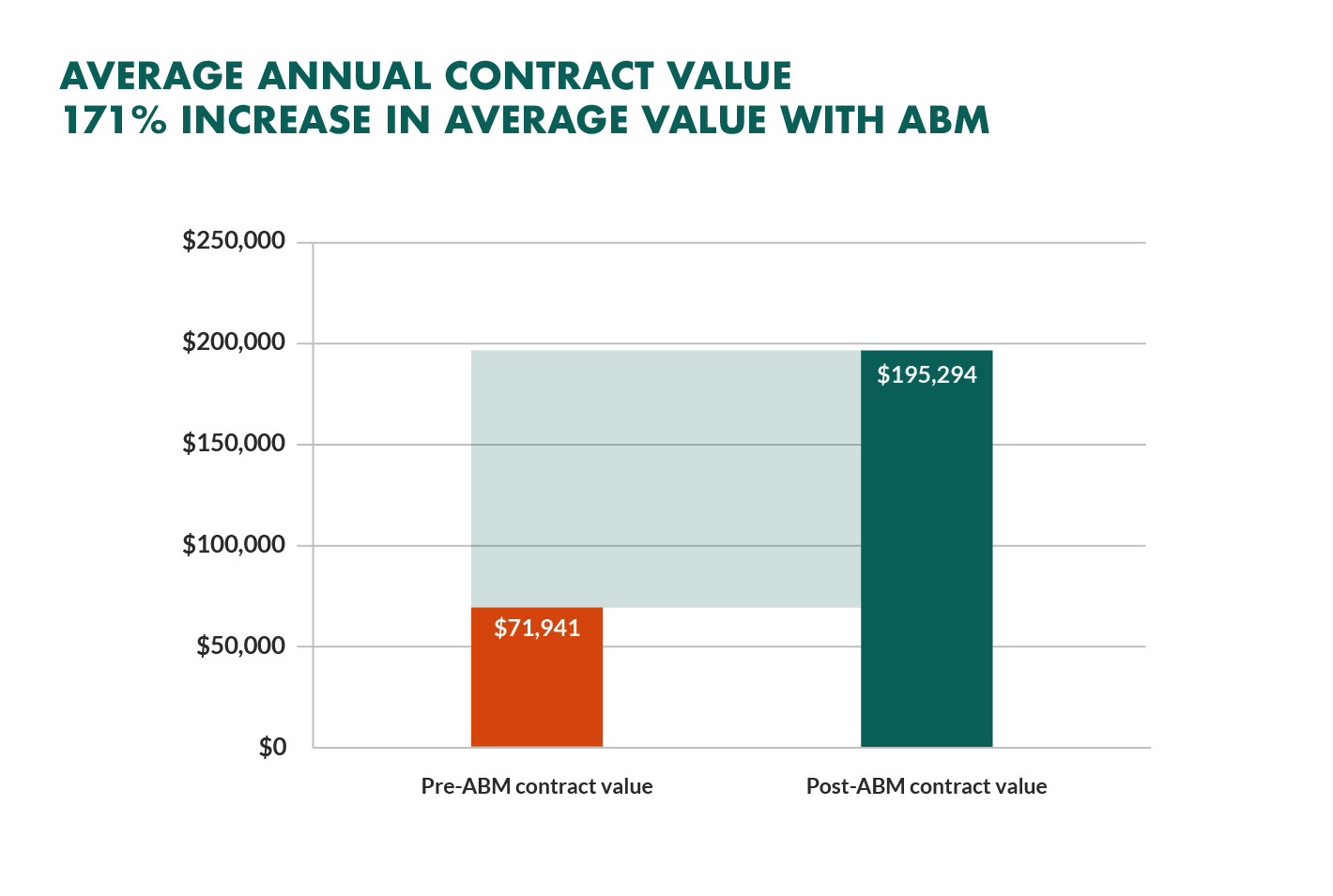
But you need a strong account-based marketing team structure to succeed. Without a proper team, even the most ambitious ABM strategy can quickly fall apart.
That’s why it’s important to know the key players and qualities of a good ABM team member before you begin structuring your ABM department.
TL;DR:
- Account-based marketing (ABM) focuses on high-value accounts, requiring a well-structured team and diverse skill sets
- Key team members include C-level executives, data analysts, strategists, designers, and content creators
- CEO, CMO, and CRO provide strategic direction, align ABM with company goals, and drive revenue growth
- Operations, Marketing, and Sales Managers oversee and execute various aspects of ABM campaigns
- Execution-based roles include Performance Marketers, Graphic Designers, Content Marketing and Strategy, Social Media Marketers, and Copywriters
- Proper team structure is critical for ABM success. It requires collaboration, strategic thinking, adaptability, and strong communication skills
- Tools like Factors.ai can optimize ABM efforts by providing insights into customer journeys, visitor tracking, and marketing ROI optimization
Account-Based Marketing Team Structure

The account-based marketing team brings together people of diverse skill sets and varying levels of expertise to come together with a focused vision.
C-Suite and Directors
The C-Suite and Directors in the ABM team have higher-level access to company information and the long-term vision to align the team towards a singular goal.
Chief Executive Office (CEO)
Before any ABM campaign is planned out, the team needs to understand the long-term vision of the company. That’s where a CEO comes into play. With the top level view of the company, the CEO can assist the ABM team plan things out, provide feedback on strategies, and assist with connecting the team to high-value accounts through their networks.
Some of the key responsibilities of the CEO in terms of the ABM team are:
- Setting the company's vision and long-term strategy
- Providing leadership and guidance to the executive team
- Building and managing relationships with key stakeholders
- Representing the company to the public and media
- Work with stakeholders for account scoring
Chief Marketing Officer (CMO)
The CMO has a critical role in the ABM team. This person helps define the strategy and keeps the ABM team aligned to the company’s goals at all times. The responsibilities may vary, but a CMO is generally involved in:
- Providing strategic direction and guidance for the ABM program
- Aligning ABM initiatives with the company's overall marketing strategy
- Collaborating with the sales team to identify target accounts and prioritize outreach efforts
- Ensuring that the ABM team has the necessary resources and tools to execute campaigns effectively
Chief Revenue Officer (CRO)
The CRO manages all things revenue and has the highest level access to the company’s inflow and outflow. A CRO can help the ABM team to:
- Bring the sales and marketing teams together to create a cohesive ABM strategy
- Ensure high-quality leads and revenue growth through the ABM program
- Approve budgets to execute campaigns as and when required
- Measure and analyzing the ROI of campaigns
- Collaborate with the marketing team to help refine the ABM strategy over time
Sales Directors
Sales directors are responsible for driving revenue growth by managing the sales team and maintaining relationships with key clients. The sales directors might be involved in:
- Collaborating with the marketing team to identify target accounts and prioritize outreach efforts
- Providing feedback on the effectiveness of ABM campaigns in generating leads and driving revenue
- Helping to refine the ABM strategy over time based on sales team feedback
- Ensuring that the sales team is aligned with the ABM program and has the necessary resources to engage with target accounts effectively.
Managerial Roles in ABM
The success of an Account-Based Marketing (ABM) campaign is heavily dependent on the leadership and management of the team. Managers oversee and help with executing various aspects of ABM campaigns.
Operations Manager
The Operations Manager oversees ABM campaigns from planning to execution. They ensure that all tasks are completed on time and that the team works efficiently. The ops manager also helps the ABM team manage the budget and execute tasks cost-effectively.
Some of the key responsibilities of the Operations Manager in ABM include:
- Overseeing the development of the ABM strategy and ensuring it aligns with the company's overall goals
- Managing the budget for the ABM campaign and ensuring that expenses are within the allocated budget
- Setting up systems and processes to track the progress of the ABM campaign
- Collaborating with the Marketing and Sales team to ensure that the campaign is effective in generating leads and revenue
- Reporting on the progress of the ABM campaign to senior management
Generally, the operations manager needs to be on top of things to ensure proper execution of the campaigns.
Depending on the org structure in the company, operations manager may also keep track of the key ABM metrics like customer acquisition, customer retention, and customer engagement.
This can help determine whether the current marketing strategies are effective and whether they need to be modified.
Marketing Manager
The Marketing Manager is responsible for the creative aspects of the ABM campaign, such as developing the messaging and designing the creatives. They work closely with the Operations Manager to ensure that the campaign is executed according to plan. Some of the key responsibilities of the Marketing Manager in ABM include:
- Developing the messaging and creatives for the ABM campaign
- Identifying the right channels to reach the target accounts
- Developing and executing marketing campaigns that align with the ABM strategy
- Measuring the effectiveness of marketing campaigns and making necessary adjustments
- Collaborating with the Sales team to ensure that marketing efforts are aligned with sales objectives
Since a major part of the marketing manager’s role is understanding analytics and data, they can greatly benefit from marketing analytics tools like Google Analytics, Factors.ai, and Microsoft Clarity.
These tools can help measure the performance of marketing campaigns, track visitors and engagement, perform revenue attribution, and identify areas for improvement.
Sales Manager
The Sales Manager is responsible for working with the Sales team to ensure that the ABM campaign is generating leads and revenue. They work closely with the Operations and Marketing Managers to ensure that the campaign is executed smoothly.
Some of the key responsibilities of the Sales Manager in ABM include:
- Collaborating with the Marketing team to identify high-value accounts
- Identifying decision-makers and key contacts within the target accounts
- Developing and executing a personalized outreach strategy for each account
- Reporting on the progress of the ABM campaign to senior management
- Nurturing relationships with key clients and ensuring their needs are met
Sales managers can also choose to employ a conversational ABM strategy to improve the sales team output. This strategy uses chatbots as the first point of contact, helping sales teams filter clients and improve conversions.
Strategy and Execution-Based Roles
While the senior-level team members provide strategic direction, the execution-based roles do the groundwork for ABM campaigns.
Performance Marketers
Performance marketers are responsible for creating and executing paid advertising campaigns. They come up with strategies to target the right audience, work with graphic designers to design ads, and monitor campaigns’ performance to optimize results. The responsibilities of performance marketers include:
- Creating the target audience and segmenting for better targeting
- Keeping track of campaign performance metrics using analytics tools like Factors and Google Analytics
- Collaborating with designers, content strategists, and copywriters to design and create ad copy and landing pages
Graphic Designers
Graphic designers play a crucial role in creating personalized and tailored designs for the ABM campaigns. But generic designs will fail to meet the standards here.
ABM designs need to capture the attention of your target audience and make a lasting impact.
Graphic designers must deliver their highest quality work, bringing creativity and innovation to the table. The designers must also have a deep understanding of the target account's preferences and expectations to truly resonate and drive engagement.
Here are some key responsibilities and qualities of a graphic designer in an ABM team:
- Collaborate with the marketing and strategy teams to create designs that resonate with target accounts
- Craft graphics for various marketing materials, such as display ads, social media posts, landing pages, and email campaigns
- Ensure that all visual elements are consistent with the company's branding and visual identity guidelines
- Optimize and repurpose graphic content for use on different social media platforms
Content Marketing and Strategy
Content is an important part of any ABM campaign. For instance, the content strategy team begins identifying topics that are important to your target audience.
The content marketing team then creates blog posts, whitepapers, and case studies around the topics to rank on search engines and be shared with the target accounts.
They may also collaborate with the sales team to identify content gaps and create additional content that speaks to the pain points of target accounts.
Some of the major responsibilities of the content marketing and strategy team may include:
- Conducting keyword research to optimize content for SEO
- Developing content that speaks to the pain points of target accounts
- Creating a content calendar to ensure consistency in messaging
- Developing and executing on a social media strategy to promote content
- Measuring and analyzing the performance of content to make data-driven decisions
Social Media Marketers
Social media marketers are responsible for ensuring regular engagement with the target accounts. They mould the social presence in a way that the target accounts find value in following your company profile—thus giving you direct access to these accounts. The responsibilities of social media marketers include:
- Creating and managing social media accounts
- Developing social media strategies that align with the ABM campaign's objectives
- Creating social media content that resonates with the target audience
- Engaging with the target audience on social media channels
Copywriters
Copywriters are responsible for creating compelling copy that resonates with the target audience. They work closely with content strategists to ensure that the copy aligns with the ABM campaign's objectives. The responsibilities of copywriters include:
- Creating copy for ad campaigns, landing pages, and other marketing materials
- Collaborating with content strategists to ensure that the copy aligns with the ABM campaign's objectives
- Conducting research to identify the pain points of the target audience
- Writing compelling copy that resonates with the target audience
Why is team structure important for ABM?
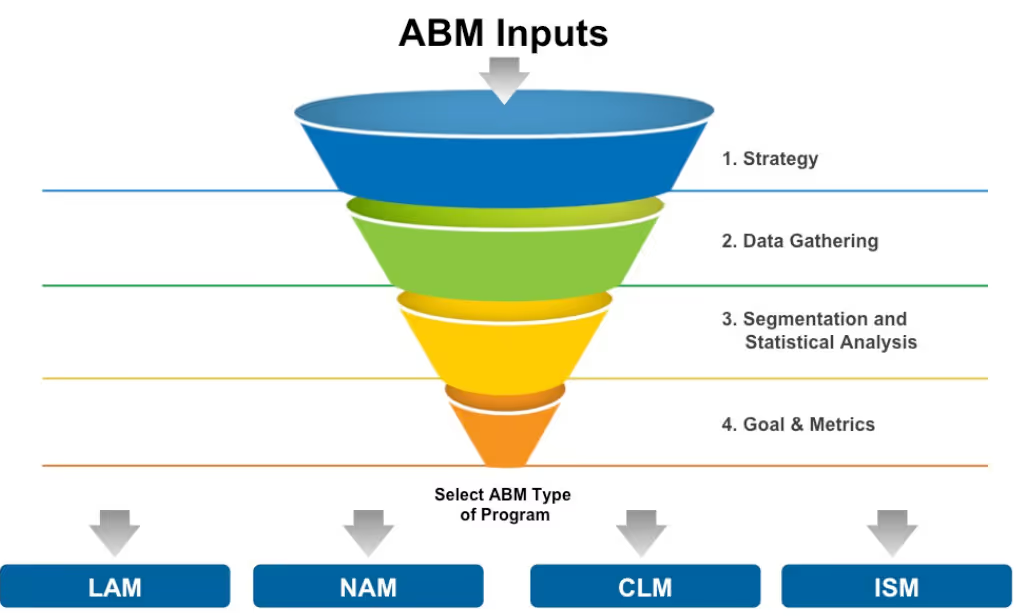
The process of an ABM campaign goes from designing the strategy, to gathering data and analyzing it, and finally executing the campaign based on the findings. But because of the highly personalized nature, account based marketing involves stakeholders from multiple teams for insights and feedback.
ABM teams need a lot of ad-hoc decision-making and creativity, so everyone on the team works towards a common goal, communicates effectively, and supports each other.
This is why proper team structure is critical to the success of ABM campaigns. It allows for seamless integration of strategies and effective collaboration among team members.
Apart from the basic understanding of the role and being able to collaborate with a diverse set of individuals, here are a few qualities of a great ABM team member:
- Use data and analytics to guide decisions and actions
- Ability to find creative solutions to challenges
- Adapt to changing situations and priorities
Achieve ABM Success With a Strong Team
A strong and effective team is crucial to the success of any ABM initiative. With the right mix of talent, expertise, and collaboration, your ABM team can unlock the full potential of your marketing efforts and drive meaningful results.
But to truly take your ABM to the next level, you need the right tools and technologies at your disposal. That's where Factors.ai comes into play. It offers deep insights into customer journeys, anonymous visitor tracking, and marketing ROI optimization, helping you to identify sales-ready accounts, automate analytics, and prove the revenue impact of every touchpoint.
With Factors, you can reduce your CAC, improve ROI, and accelerate revenue growth seamlessly. Schedule a demo today and see for yourself how Factors can transform your ABM approach and drive more pipeline with less spend.
FAQs
1. What qualities should I look for when building my ABM team?
Here are some of the qualities to look for in an ABM team member.
- Strong collaboration skills
- Strategic thinking.
- Analytical mindset
- Adaptability for constantly changing environment
- Creativity
- Strong communication skills
2. How do I create an ABM team?
Creating an ABM team involves understanding your end goals and finding people to fill the talent and skill gaps within your marketing and sales teams. However, here are the general steps to build your ABM team.
- Establish the end results you want to achieve with an ABM team
- Based on the goals, identify what skills and expertise is needed for your marketing team. This could include account management, data analysis, content creation, and project management
- Hire people with the required skill sets and establish clear roles and responsibilities for each of the new team members
- Create an open environment for the team to collaborate with the stakeholders as an when required for the successful execution of your ABM campaigns
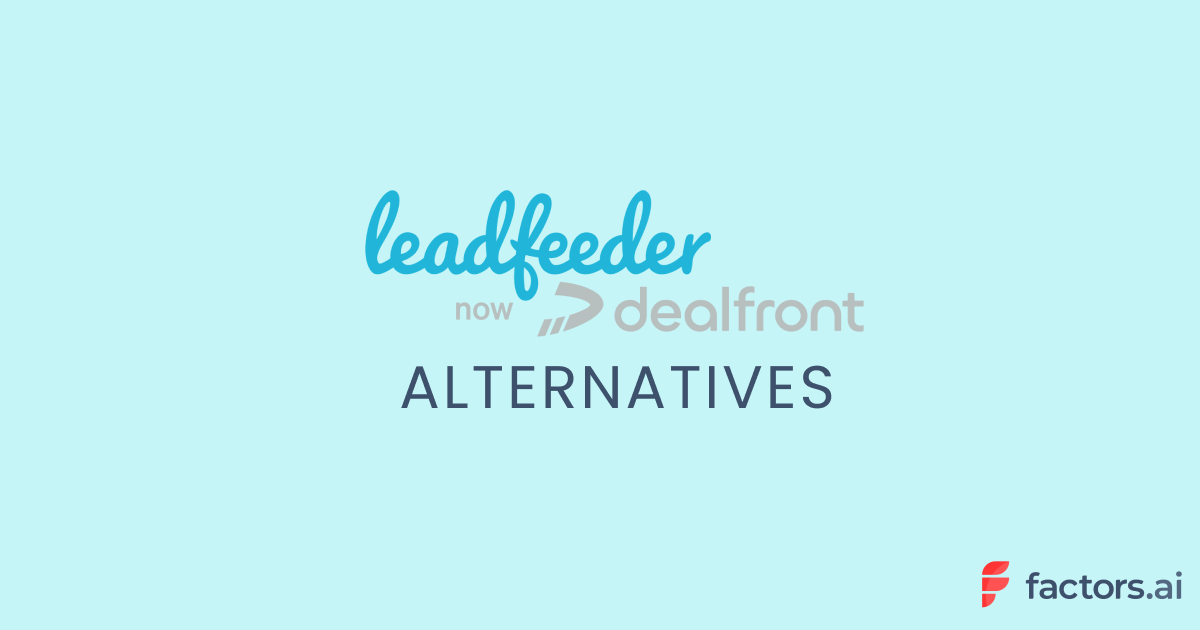
Best Leadfeeder Alternatives For Website Visitor Identification
It’s official. Leadfeeder has joined forces with Echobot to form Dealfront — a Europe-centric go-to-market platform. As a result of this merger, Leadfeeder’s pricing plans have increased to start at $215+ per month with limited seats and data.
Several Leadfeeder users are looking for comparable sales intelligence alternatives to help identify and track anonymous website visitors.
If you’re in the same boat, or are simply considering your options, this is the right place for you.
The following article explores 5 comprehensive Leadfeeder alternatives to help your team make a seamless switch. We'll highlight key features, benefits, and drawbacks with each Leadfeeder alternative.
By the end of this article, we’d like to help you find an equally effective, if not better, alternative to your current visitor identification tool.
Looking to learn more about visitor identification? Check out these further readings:
Leadfeeder Alternatives For Website Visitor Identification
1. Factors.ai
Leading off our list is Factors.ai. Factors is unique in that it’s originally built upon strong analytics and attribution foundations. A recent partnership with 6sense, a leading enterprise-grade ABM platform, has propelled Factors into becoming a rising star in the visitor identification software space.
With this collaboration, Factors delivers industry-leading visitor identification, firmographics, and account timelines along with its existing ABM analytics and multi-touch attribution capabilities.
Factors.ai Key Features
Here’s a brief breakdown of Factors.ai’s key features
1. Account Identification
Of course, every tool featured on a list of Leadfeeder alternatives must be capable of identifying and tracking accounts visiting the website. Factors is no exception to this. In fact, as a result of its collaboration with 6sense, Factors taps into enterprise-grade IP data to identify up to 64% of anonymous companies — including firmographics (employee headcount, industry, location, etc) and website activity (page visits, time spent, scroll-depth, etc).
Factors also provides real-time Slack alerts to help teams stay on top of high-intent visitors and strike while the iron’s still hot. These alerts can be configured to go off based on specific firmographic features and website behavior — so you can target ICP companies visiting your site.

2. Account Scoring & Timelines
Factors integrates with campaigns, website, and CRM data to provide cross-channel account scoring and full-funnel timelines across the customer journey. With this feature, users can see exactly what touchpoints (ads, blogs, emails, webpages, etc) are influencing accounts to progress from top-of-the-funnel visitors to paying customers. Users can identify and prioritize high-intent accounts for focused outreach and re-marketing efforts
3. Advanced Analytics:
Unlike other solutions on this list (including Leadfeeder), Factors provides a wide range of analytics and attribution capabilities in addition to visitor identification. A few advanced analytics features include:
- ABM analytics - Integrates with ad platforms, CRMs, CDPs and more to unify reporting and support campaign analytics, website analytics, funnels, and more at an account level.
- Path analysis - View aggregate user behavior and identify points of inflection in conversions and drop-offs along the customer journey
- Multi-touch attribution - Connect the dots between go-to-market initiatives and pipeline, optimize resource allocations across campaigns, and prove marketing ROI with a wide range of multi-touch attribution models.
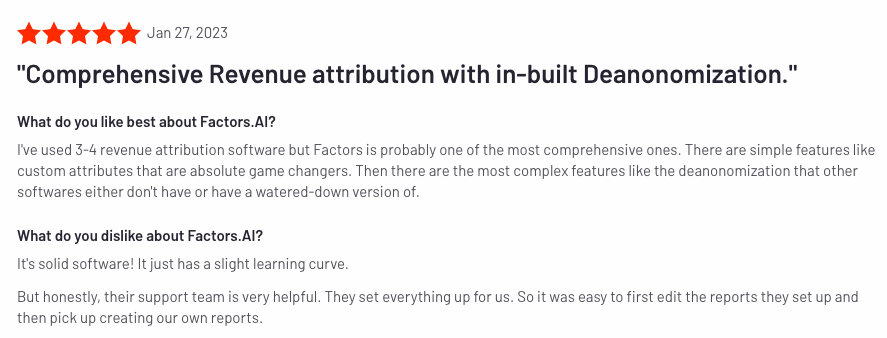
{{INLINE_CTA_A}}
Benefits of Factors.ai
Here are a few reasons why you may prefer Factors.ai to other tools:
1. Data accuracy: As previously mentioned, Factors taps into 6sense’s extensive database to provide industry-leading website visitor identification. In fact, rigorous testing with a sample data set of over 20,000 domains reveals that Factors identifies upto 27% more accounts than the closest alternatives — including established brands such as Clearbit and Demandbase.
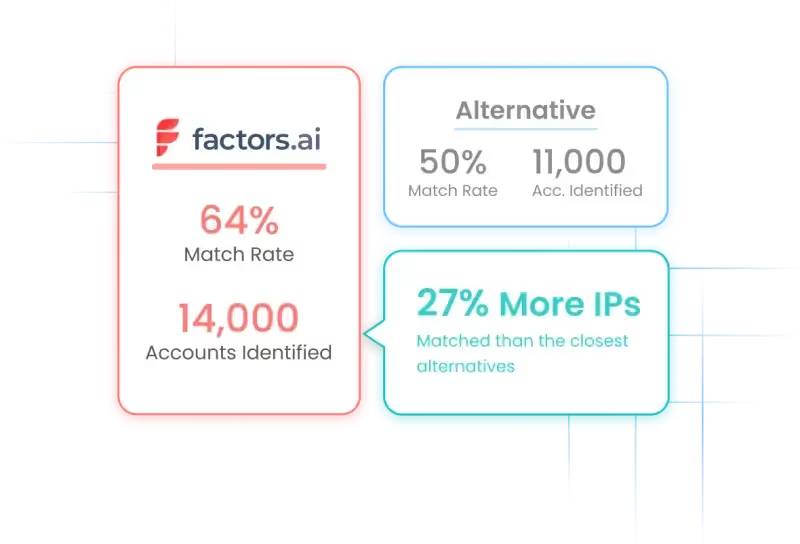
2. Granular metrics: Given Factors’ roots in account analytics, it’s capable of reporting granular metrics and events as compared to other visitor identification alternatives. A few of these include:
- % scroll-depth
- Auto-button captures
- Cursor engagement
- Page time spent
3. Scoring & Alerts: Not all your website visitors are immediately read-to-buy. Some are further along the funnel than others. According, Factors supports custom account scoring models so you can qualify and be alerted to high-intent, ICP accounts engaging with your company in real-time.
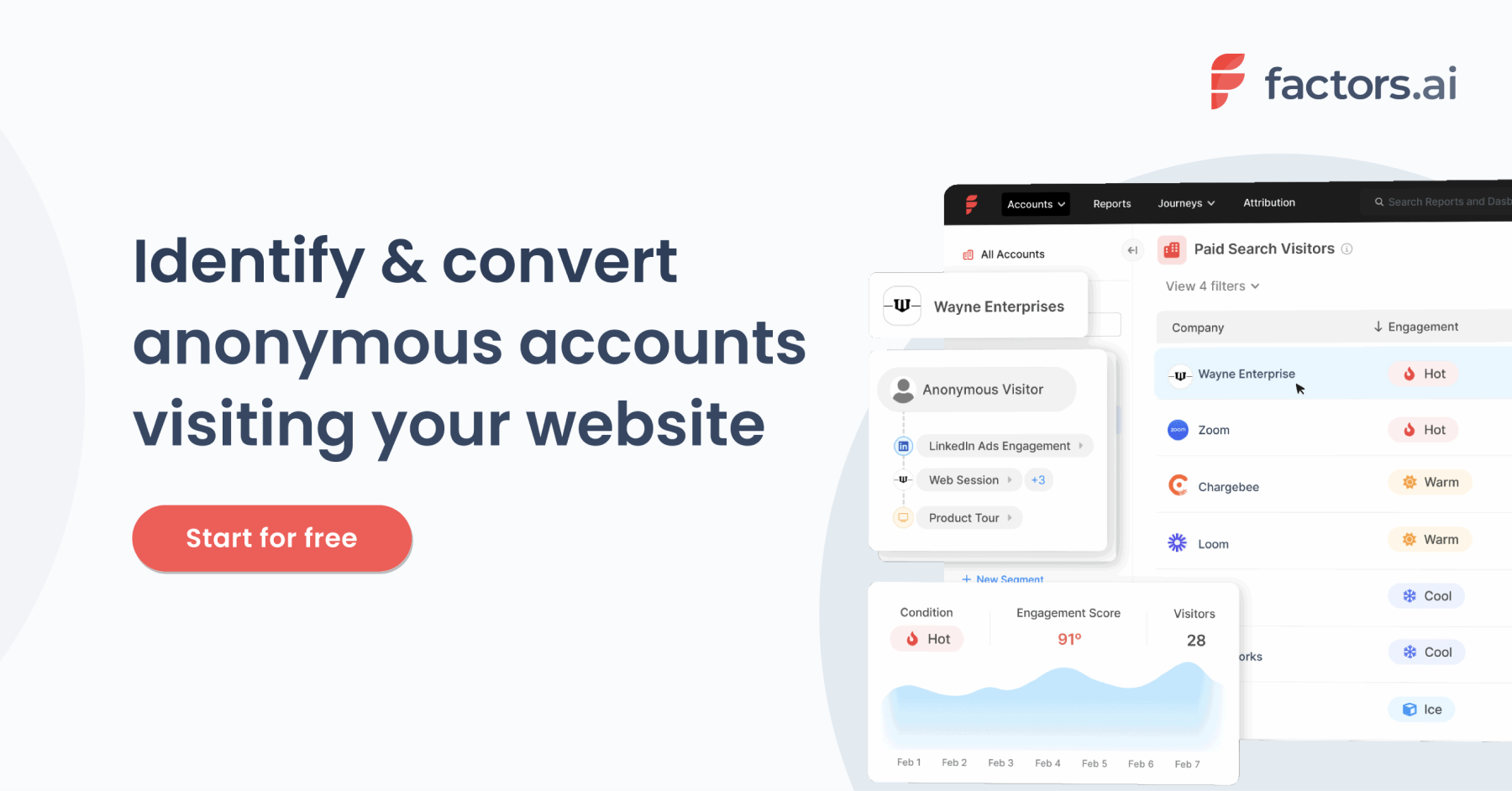
Drawbacks of Factors.ai
Contact-level enrichment - No privacy-compliant software can identify exactly which individual visited a website without having a visitor explicitly submit a contact form. That being said, the majority of tools on this list can source a list of ideal prospects to reach out to from the companies they’ve identified.
At the moment, Factors cannot provide this information natively. Instead, users can find contact information on third party tools such as Zoominfo or Apollo.
Factors.ai Pricing
Learn more about pricing here: factors.ai/pricing
Curious to see Factors in action? Book a personalized demo here.
{{INLINE_CTA_A}}
2. Albacross
Next up, we have Albracross. Albracross is one of the leading visitor identification and intent data companies in Europe. The Sweden-based platform works with over 10,000 companies to provide customer data enrichment, sales alerts, and intent signals.
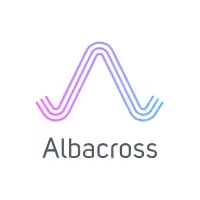
Key Features
1. Account Identification: Like the other tools on this list, Albacross identifies anonymous accounts, firmographic information and visitor intent. Albacross features one of the largest proprietary first-party databases in the world.
2. Personalization: Albacross natively integrates with popular personalization tools such as Optimizely and VWO to customize website content based on who’s visiting the site. This is a powerful feature for product marketers looking to identify visitors and tailor messaging based on their profiles.
3. Display ads: A nifty feature offered by Albacross is the ability to launch and monitor display ads within the platform itself. The software partners with several publicists such as The New York Times and Daily Mail to distribute account-level targeted ads.
Benefits of Albacross
Here are a few reasons why you may prefer Albacross to other tools:
1. Experimenting: Given that Albacross is one of the few Leadfeeder alternatives to integrate with personalization tools, it offers the unique benefit for product marketers to experiment and run A/B tests in conjunction with visitor identification and intent data.
2. Customer success: Several reviews rave about Albacross’s stellar customer success management. Given that Albacross is considered to be an involved, enterprise-level tool, it’s essential to have this level of support to get the most value out of the product.

Drawbacks of Albacross:
Here are a few reasons you may consider other tools over Albacross:
1. Rigid firmographics and filters - Albacross seems to lack agility when it comes to filters and breakdowns. Reviews reveal that it’s currently not possible to filter identified companies based on firmographics such as name or size. As a result, users seem to find sorting and reporting somewhat challenging.

2. Buggy integrations: Multiple reviews claim that Albacross’s integrations, especially with CRMs like Salesforce, could do with some work. Given that visitor identification is primarily used to support ABM, this can be a major drawback to B2B teams. Tools like Zapier may be used to smoothen out workflows for now.

3. Lead Forensics
Founded in 2009, Lead Forensics is the oldest, most established website visitor identification software in this list. They own a sizable database of over 1.4 billion IP addresses, adding up to 55 millions contacts every year.

Key Features
Lead Forensics doesn’t have too many bells and whistles as compared to the other tools on this list. Its primary features are limited to visitor identification and contact data.
1. Account identification: Like Leadfeeder, Factors, and Albacross, Lead Forensics identifies anonymous businesses visiting your website by connecting the dots between IP addresses and company names. In the case of multinational companies, Lead Forensics is capable of showing which specific office is interacting with your website. This is handy for businesses looking to sell to large corporations.
2. Contact data: Lead Forensics also helps teams identify key contacts within companies visiting your website to assist with retargeting and outbound reachout. Here’s a brief summary of the kind of details that Lead Forensics can provide:
- Business name
- Contact details of key decision makers
- Telephone, email and LinkedIn details
- Demographics
- Search behavior
- Financial data

Benefits of Lead Forensics
A unique benefit with Lead Forensics is its mobile application. With their “Essential” plan, users can have trigger reports sent directly to their phones.
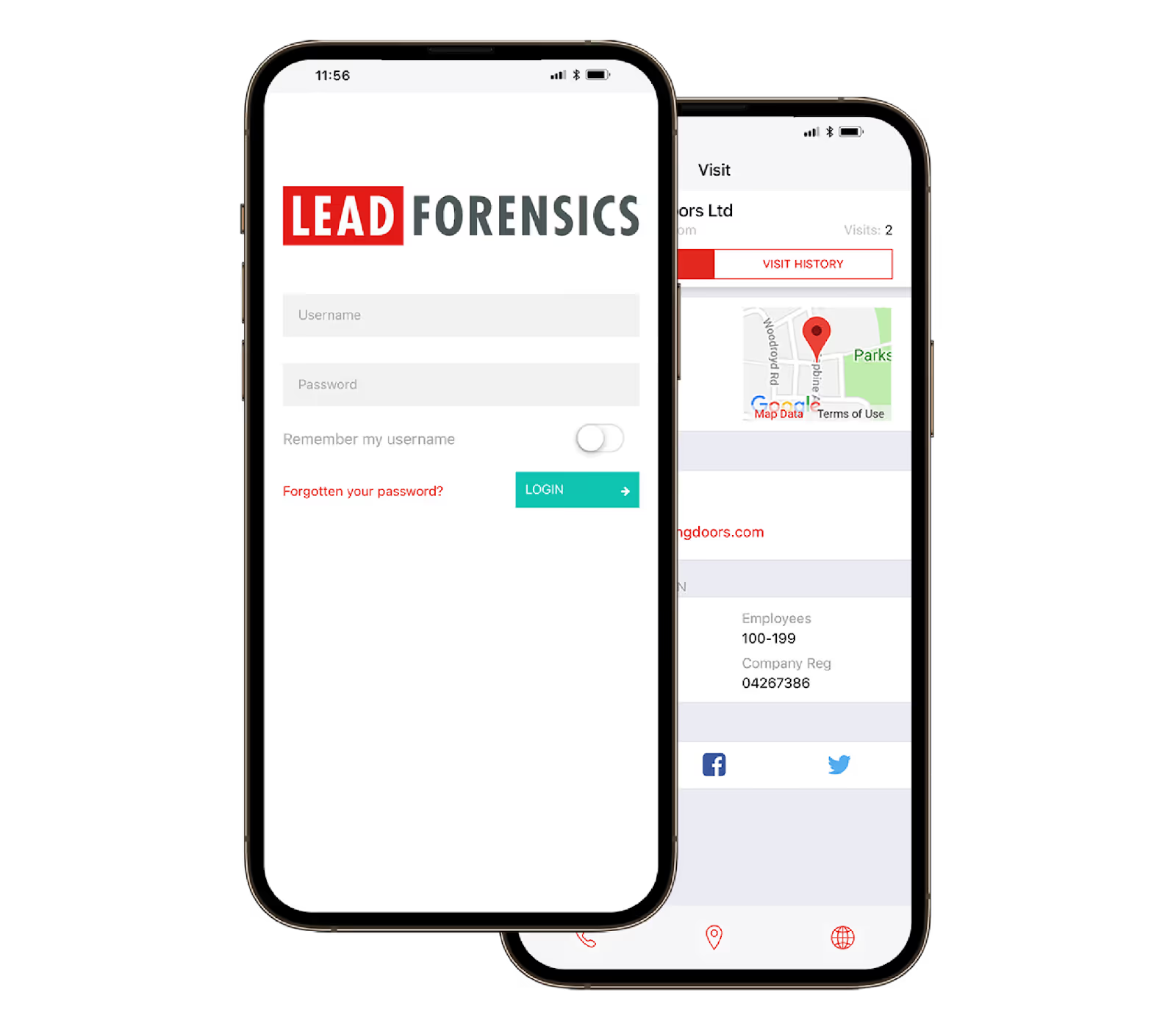
Drawbacks of Lead Forensics
Here are a few reasons you may consider other tools over Lead Forensics:
1. Poor UI - Lead Forensics is one of the oldest visitor identification software around. While experience is generally a positive sign, several users complain about Lead Forensics’ UI remaining outdated and unintuitive. Users find the tool to have limited functionality in terms of ad-hoc analysis, dashboards, and filters as well.
2. Pricing - While Lead Forensics does not openly reveal its pricing plans, it’s generally considered to be on the more expensive side. While this may not be a barrier for larger, enterprise-level companies, pricing may be prohibitive for small to mid-market start ups — especially when there are cost-effective alternatives available.

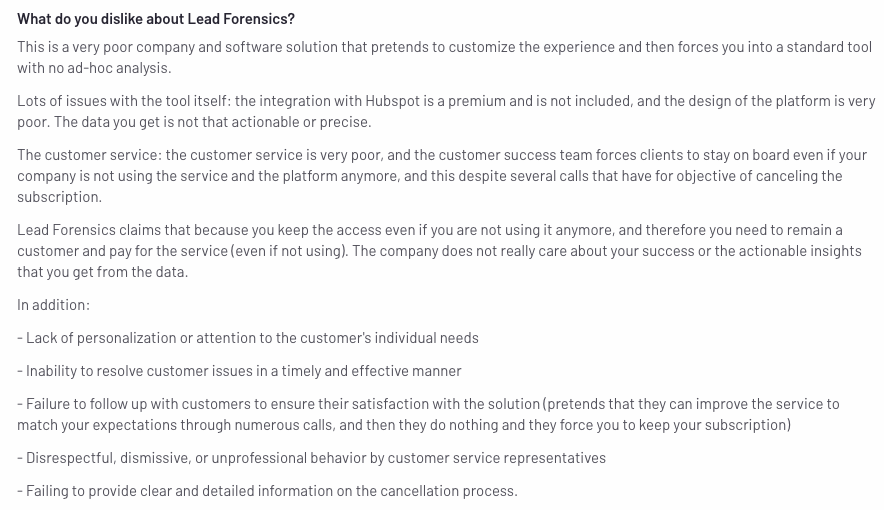
{{INLINE_CTA_A}}
4. Clearbit
Fourth in our list is Clearbit. Clearbit is another well-established B2B data activation platform that offers a wide suite of products within its platform.

Key Features
Clearbit is divided into three broad products:
1. Reveal - Clearbit identifies anonymous website visitors using IP-lookup. Given that every tool on this list does this, data accuracy and pricing are two important considerations when differentiating between alternatives.
2. Enrichment - Clearbit also provides firmographics from over 250 data sources. This includes technologies, headcount, revenue, location, contact information, and more.
3. Capture - like Leadfeeder Contacts, identifies best-fit contacts from companies visiting your website to reach out to with retargeting campaigns or outbound efforts

Benefits of Clearbit
1. Free plan: While Clearbit’s paid plans are relatively expensive, they offer a nifty free plan to de-anonymize anonymous traffic. That being said, the free plan is quite limiting as users can enrich only 50 domains a month. This becomes an issue as website traffic starts to scale over time. Still, it’s free — so who can complain?
Here’s a breakdown of what Clearbit’s free plan offers:
- Identify site traffic
- Calculate total addressable market size
- Determine ideal client profile
- Enrich domains and emails (up to 50 per month)
- Find email addresses (up to 100 per month)
2. Smart chat: Smart chat is a handy feature for sales reps to connect with high-value, high-intent visitors with personalized conversational ABM while visitors are live on the site. Chat prompts can be triggered based on visitor characteristics and behavior such as industry, page views, headcount, etc.
Drawbacks of Clearbit
1. Pricing: Clearbit does not reveal pricing details on its website. But several user reviews suggest that pricing is on the higher side for early to mid-stage startups.

2. Customer support: Clearbit works with a wide range of clients from early-stage startups to enterprise-level companies. Users from the former seem to face issues when it comes to customer support, claiming that it’s often slow and inadequate.

5. Visitor Queue
The final option on our list is Visitor Queue. Visitor Queue is a Canada-based visitor identification and personalization platform that identifies the name, contact detail and user data of accounts visiting your website.

Key Features
1. Visitor identification: What separates Visitor Queue from the rest of the tools on this list is its ability to aggregate company social profiles in addition to standard firmographics and contact information.
2. Personalization: Like Albracross, Visitor Queue allows users to personalize their website based on configurable criterias such as industry, source/medium, location, and more. This helps product marketers differentiate their brand from competitors and experiment with different messaging to improve conversions.
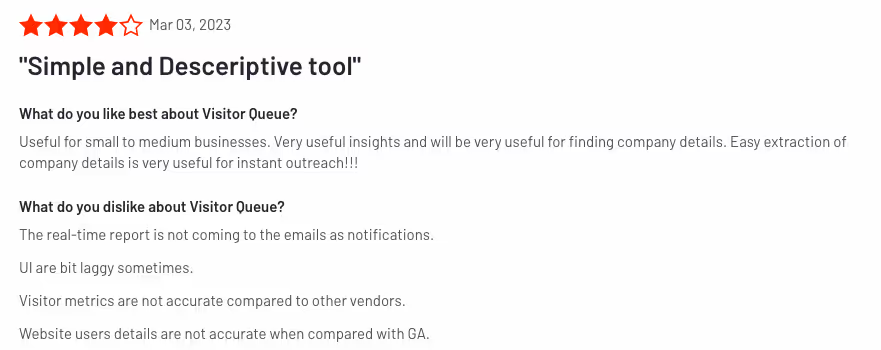
Benefits of Visitor Queue
1. Unlimited users - Most tools on this list (excluding Factors.ai) limit the number of seats per account. Given that visitor identification is used by sales, marketing, and customer success teams, it’s valuable to have an unlimited number of users with Visitor Queue.
2. Pricing - Visitor Queue is a more affordable option as compared to the likes of Clearbit and Lead Forensics with prices starting at just $31/month to identify 100 companies per month. This makes it a good option for early-stage teams that are working with tight budgets.
Drawbacks of Visitor Queue
1. Rigid reporting - While Visitor Queue does well at the basics, users complain about its restrictive UI when it comes to ad hoc reports, filters, and dashboards. As a company starts to grow, its requirements for tailor-made reporting do too. Visitor Queue wouldn’t back a good fit for custom usage.

2. Data issues - User reviews complain about data inaccuracies with Visitor Queue. While no tool is perfect, Visitor Queue seems to lag behind industry-standards in terms of accurately identifying visitors. While it’s great to have an inexpensive alternative, a visitor identification tool won’t be of much value unless it identifies the right visitors.

And there you have it! A brief summary of 5 comprehensive Leadfeeder alternatives to help you identify anonymous website visitors. Each of these tools have their pros and cons — and one is likely to be better suited to your needs than the others.
Top Leadfeeder Alternatives
Businesses seeking cost-effective and feature-rich website visitor identification tools can explore various alternatives.
1. Leading Alternatives: Factors.ai for advanced analytics and attribution, Visitor Queue for affordability and effective lead tracking.
2. Key Features: Pricing flexibility, seamless integrations, high data accuracy, and real-time visitor insights.
3. Decision Factors: Evaluate based on budget, integration needs, and business-specific requirements.
Selecting the right platform enhances lead generation, improves marketing efficiency, and drives better conversion rates.
Let’s make the decision easier for you:
- If pricing and account-level data accuracy are priorities, Factors.ai is likely the best option.
- If the ability to personalize your website based on who’s visiting your site is what you’re looking for, Albacross and Visitor Queue are two great options.
- If you’re a larger enterprise without budget constraints, Clearbit could be the right option.
Factors.ai identifies up to 64% of anonymous visitors — the highest match rate in the industry. Looking to learn more about how Factors can help? Book a personalized demo here!
{{INLINE_CTA_A}}
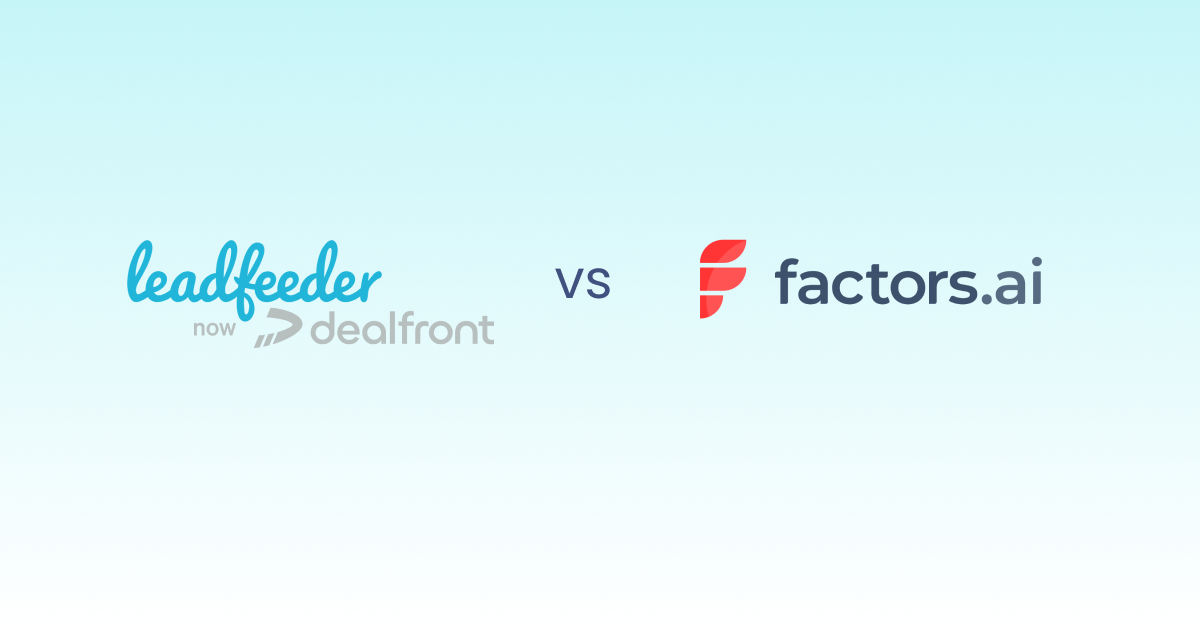
Leadfeeder [Dealfront] Vs. Factors: Compare Pricing & Features
Leadfeeder is a well-established B2B lead generation software that helps go-to-market teams identify and enrich anonymous website traffic. Leadfeeder has recently joined forces with another sales intelligence platform, Echobot, to form Dealfront — a Europe-centric B2B data platform.

As a result of this collaboration, Leadfeeder has consolidated multiple products, increased pricing plans, and limited the number of seats per account. Accordingly, several former-Leadfeeder users are considering switching to IP intelligence alternatives.
While Factors is a relatively new player in the account identification space, it’s quickly emerging as a popular alternative to Leadfeeder given its cost-effective plans and industry-leading match rates of up to 64%. That being said, every platform has its unique advantages and limitations that must be considered before making a purchase decision.
This blog compares Leadfeeder vs Factors to highlight features, benefits and drawbacks of each tool — and explore why one might make more sense for your use-cases over the other.
Leadfeeder vs. Factor.ai
Before diving into the differences between Leadfeeder and Factors, it’s worth highlighting a few commonalities between both tools given that they’re close alternatives to each other.
1. Account identification
Needless to say, identifying anonymous accounts on your website is a core functionality of both Leadfeeder and Factors. Both visitor identification tools use IP-based targeting technology to match anonymous traffic with company IPs so users can see who’s visiting their website without the need of form submissions or gated content.
This provides valuable insights into the nature of website traffic as well as which accounts to go after with retargeting ads or outbound outreach.
While both Leadfeeder and Factors rely on similar technologies, the accuracy with which they identify visitors can vary dramatically based on their respective databases. More on this later.
2. Account-level enrichment
Along with identifying company names, both Leadfeeder and Factors deliver robust account-level firmographic enrichment data such as industry, employee headcount, geography, revenue-range, and much, much more.
Account-level enrichment helps go-to-market teams quickly qualify whether a lead fits the target audience or ideal customer profile. This in turn helps focus marketing initiatives and sales outreach to a highly targeted set of accounts — as opposed to expensive and ineffective spray and pray tactics.
3. Implementation
Given that Leadfeeder and Factors employ similar IP-lookup technology to identify and track visitors, the implementation process is more or less identical. Both tools have quick and intuitive onboarding that involves the insertion of a light-weight code script onto the website. The script will soon start identifying visitors once activated.
Overall, the entire implementation process takes no more than 10min for either solution.
4. Real-time alerts
A really nifty feature offered by Leadfeeder and Factors is the ability for users to receive real-time Slack notifications when high-intent accounts are live on the website. These alerts can be configured to go off only when specific visitor criteria are met. For instance, teams can be notified only when a visitor is from a US-based SaaS platform with at least 100 employees and is on a high-intent page such as pricing.
Research suggests that contacting leads quickly dramatically improves chances of conversions. Accordingly, this is an especially valuable feature for sales reps looking to strike while the iron’s still hot.
5. Privacy-compliance
Leadfeeder and Factors are 100% privacy compliant. Both tools adhere to GDPR and CCPA privacy policies. Factors is also SOC2 type II certified. SOC2 information about Leadfeeder is not publicly available so we refrain from commenting on this.
With common features out of the way, let’s discuss what each visitor identification solution does better than the other.
What Factors does better than Leadfeeder
Here are a few reasons to consider Factors over other alternatives:
1. Data accuracy (outside Europe)
Rigorous comparative testing over a sample size of 20,000 domains reveals that Factors achieves industry-leading match rates of up to 64%.
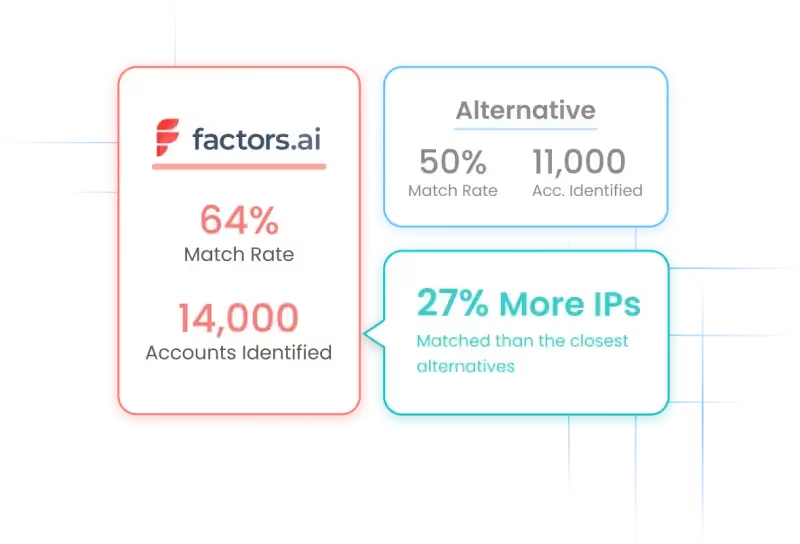
No doubt, both Leadfeeder and Factors boast impressive IP databases. In fact, Leadfeeder is at the forefront of IP-matching for Europe-specific data. Challenge with Leadfeeder may surface when targeting companies from US and other geographies outside Europe:
Leadfeeder records IPs for a whopping 26 millions companies in Europe but only about 8.5 million companies in the US and the rest of the world. Factors, on the other hand, covers almost double this figure with over 15 million companies.
Accordingly, if your business solely focused on the EU market, Leadfeeder is likely the better choice. But for global business, including the US, Factors should be the default. It taps into a relatively larger IP database to identify a wider range of companies from the rest of the world.
2. Account timelines
Account timelines is a feature unique to Factors that helps users visualize customer journeys and touchpoints in real time at an account and user level.
This is a powerful tool, especially in conjunction with visitor identification, to identify what influences different stakeholders within the same account to move from the awareness stage of the customer journey to closing the deal.

3. Advanced analytics
Factors is built upon strong analytics and attribution foundations. As a result, it’s capable of far more granularity in terms of reporting metrics and KPIs as compared to other marketing intelligence tools.
Factors auto-tracks website KPIs including:
- Page views
- Button clicks
- Percentage scroll depth
- Session duration
- Funnels (Eg: Homepage >> Pricing >> Blog >> Features)
- Custom KPIs and more
In addition to these out-of-the-box analytics, Factors integrated with ad platforms, website, CDPs, and CRMs to deliver powerful multi-touch attribution, path analysis, automated AI-fuelled insights, and more. In short, when it comes to analytics, Factors sheds light on what you need to know to drive more pipeline with less spend.
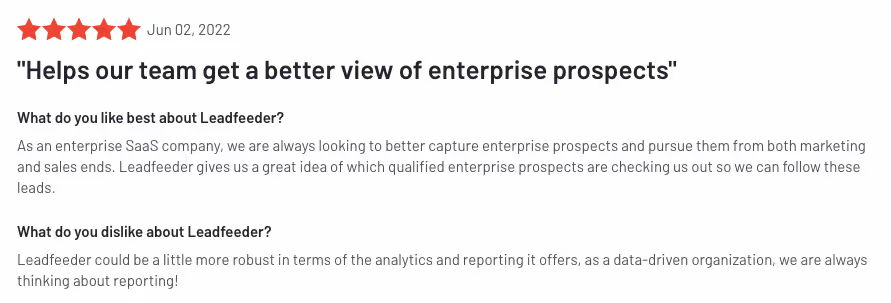
4. Customer success
While both Leadfeeder and Factors are relatively intuitive platforms, there’s no denying that they’re sophisticated products with at least some learning curves. With such products, it’s imperative to have onboarding support and dedicated customer success management — both of which Factors takes great pride in offering.

What Leadfeeder does better than Factors
Here are a few reasons to consider Leadfeeder over other alternatives:
1. Contact enrichment
While no solution can identify exactly who’s visiting your website at a user level, Leadfeeder natively provides users with a list of ideal prospects from the companies visiting a website.
For example, a fintech company may target the finance team from SaaS companies with over 10M in ARR. In this case, Leadfeeder can more or less find the contact info of CFO, VP finance, finance manager etc from companies already visiting your website — even though these professionals may not actually be the ones visiting.
This is useful for teams who’d rather not rely on specialized sales intelligence tools like Zoominfo or Apollo for dedicated contact-level data.
At the moment, Factors integrates with Apollo to provide this contact-level information. Since the majority of users rely on third-party service providers for contact information, this does not tend to be a blocker.
2. Integrations
Leadfeeder provides several native two-way integrations with popular sales and marketing tools including:
- Pipedrive
- Salesforce
- Activecampaign
- Mailchimp
- HubSpot
- Zapier
This helps users automatically upload account and contact information directly to their go-to-market tools and CRMs.
Factors integrates deeply with ad platforms, CRMs, CDPs, and more. While Factors does not provide native integrations with the full range of solutions Leadfeeder supports, it does integrate with Zapier/Make.com to support data pushback via Webhooks. At the moment, users can download csv files from Factors and upload them back into their preferred CRM, MAP, etc.
3. Native campaigns & promotions
Leadfeeder’s Promote feature allows users to target specific company IP-addresses with programmatic display ads across Google, Rubicon, Appnexus, and Pubmatic.
While the efficacy of display ads continues to be hotly debated, this may be a useful way to target companies that already visit your website and fit the ideal customer profile. The primary metrics to track these campaigns are impressions, CTR, and website visits.
Compare Leadfeeder Pricing
Leadfeeder is a relatively inexpensive solution as compared to established Leadfeeder alternatives such as Clearbit and Albacross. That being said, its recent collaboration with Echobot has revised pricing:

Now, Leadfeeder plans start at €139/mo ($152) to identify up to 100 accounts per month
Factors, on the other hand, continues to remain one of the most cost-effective marketing intelligence tools out there with plans starting as low as $99/month for up to 350 accounts identified and enriched per month. Factors pricing is based on the number of monthly website visitors and follows a gradient. Learn more about our pricing here: factors.ai/pricing
What’s the right tool for you?
This blog has compared Leadfeeder vs Factors.ai in terms of features, benefits, and drawbacks. Depending on your use-cases, one is likely to make a better fit for you than the other. Here are a couple of considerations:
- If data accuracy outside of Europe, cost-effectiveness, and holistic account scoring is a priority to you, Factors is likely better choice.
- If Europe-centric data and native contact enrichment is a priority to you, then Leadfeeder may be a better fit.
If you’d like to see how Factors achieves industry-leading match rates of up to 64%, book a demo here: See Factors in action

6 Tips to Align your Sales and Marketing Teams
Sales and marketing are like twins that don’t get along. Teams often confuse the two because they work along similar lines. In fact, both teams are often given a shared budget to divide amongst themselves.
In a study conducted by Harvard Business Review, when sales and marketing teams were asked to describe each, the two had nothing but negative comments. “Paper pusher” and “irrelevant” were the top terms used to describe the marketing team. On the other hand, some words that the marketing team used to describe the sales team included “incompetent” and “simple-minded” (Source).
Of course, this rift between sales and marketing has existed since the beginning of, well, sales and marketing.
But what if…what if…both sales and marketing could join forces to work together?
What can sales and marketing teams achieve when tightly aligned?
Well, organizations that have their sales and marketing teams on the same page enjoy the following:
- 36% higher customer retention rates
- 38% higher win rates (Source)
- 67% improvement in deal closures
- 209% more revenue from marketing (Source)
- 20% annual growth rate (Source)
- Save 30% Customer Acquisition Costs (Source)
Then the next question is—How can you get your sales and marketing teams on the same page? Here are a few tips that will help!
6 strategies to align sales and marketing
1. Align Goals to ROI
Sales and marketing teams have different ways of looking at their goals. While sales teams have monthly, quarterly, and annual deadlines, this concept is foreign to the marketing team that has never been linked to revenue performance.
Since both teams work in different styles, confining either one to follow the other process will result in unnecessary friction.
But the one thing that doesn’t change is their goals.
In the end, both their goals should be improving ROI. Taking the focus away from the journey and putting it on the result can even both the teams’ paces and unite them.
2. Employ Lead Qualification
Another area where both teams find themselves at odds is when a successful campaign from the marketing team does not translate into higher conversions for the sales team.
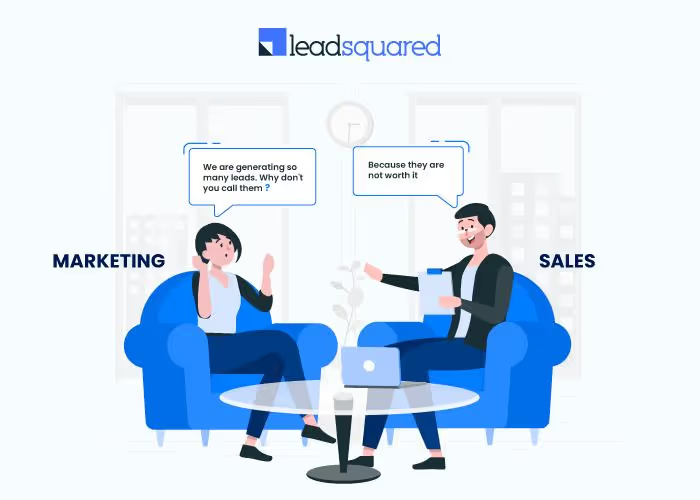
The culprit behind this is lead quality.
If the leads being generated are not interested in buying the company’s product, no matter how many prospects flow into your sales funnel, the end conversion rate will be the same.
One way to improve lead quality is by qualifying them.
Apart from this, lead qualification offers three other benefits: it help the marketing team understand whom they’re supposed to target, get both teams on the same page, and reduce the sales team’s efforts.
Then, how does one employ lead qualification?
One way to qualify a lead is to get both teams to sit together and build an ideal customer profile (ICP). An ICP is basically a customer profile of the business’s ideal buyers. It answers questions like how much they would be willing to spend, where they are more likely to live, what communication channels they are more likely to use, and what they are looking for.
The next step involves setting up a presales team that sorts the leads into invalid, uninterested, partly interested, and interested, before sending the leads forward. The invalid and uninterested leads get discarded.
The marketing team’s goal is to reduce the number of invalids and uninterested leads, whereas the sales team’s job is to convert the remaining two categories into clients.
These two steps can result in smoother operations between sales and marketing.
3. Use a CRM
Lack of communication is the biggest reason for disconnected sales and marketing teams. Since sales and marketing teams are usually swamped with their own work, it can get tricky to find time to interact with each other.
A Customer Relationship Management Software solves this problem by centralizing information. This allows different teams to access resources and monitor each other’s activities, keeping everyone on the same page.
CRMs also help nurture leads, track journeys, decrease duplication of efforts, provide deeper insights and analytics about customers, and score leads, all of which allow better decision-making and harmony between teams.
And if that isn’t enough, the software also provides sales and marketing automation, speeding up the groups’ efforts and saving them time.
4. Invest in Sales Enablement
Sales enablement is one of the most common methods companies employ to align their sales and marketing teams. How it helps companies is by:
1. Encouraging marketers and sales reps to interact
The marketing team needs to notify the sales team whenever they update new content. This forces them to reach out and interact with the sales reps. Similarly, sales reps must provide feedback on how the content helps them and what improvements can be made, thus, improving communication between the two.
2. Giving marketers and sellers an idea of what content resonates with customers the most
Once marketers create new content, they understand which content the sales team uses more and which is used less, thus helping them make better content to enable the reps.
Sales reps can also understand the type of prospects they are interacting with through the marketing team’s enablement content. This allows them to change their pitch according to the customer segment they are dealing with, which results in more closures.
3. Ensuring that the content remains on brand
When sellers have difficulty finding the right content, they might modify the material they already have to suit their sales purposes. This saves them time, but it might not necessarily be brand compliant.
Sales enablement allows representatives to modify materials on the fly using only pre-approved content. Furthermore, it gives marketers access to each modification made by each seller. This allows the marketing team to analyze what sellers are looking for in the material and which ones they are finding difficulty in navigating. This will be really beneficial for future asset optimization and improvement.
5. Attend Each Other’s Meetings
For companies that haven’t yet employed a CRM or an update tracking software, the best way for sales and marketers to keep tabs on each other’s updates is by actually attending their meetings.
Or better still, holding a dedicated joint meeting weekly or monthly can bring both teams on the same page. This ensures everyone is on the same page regarding that quarter's goals, tactics, expectations, strategies, and performance progress.
Here are some tips for holding a fruitful sales and marketing meeting
1. Set a proper agenda
Collect the agendas to be discussed beforehand and allot specific times for them to ensure all the topics are discussed. Remember to keep buffer time in case the topics drag on and the time taken to finalize a decision on that agenda.
2. Keep changing the themes
One way to avoid having complicated agendas with broad topics is by grouping them under different themes. Keeping one theme per weekly meeting can simplify the agenda and burden both teams less.
Some popular sales and marketing themes include:
- Strategies Discussion – Held to discuss the strategies that have been working and the strategies that need to be changed or dropped.
- Performance Reviews – How the teams’ efforts contribute to achieving goals and how much they have progressed.
- Buyer Behaviour – Held to discuss any changes and improvements that can be made regarding buyer engagement or to discuss the results of an already published campaign.
- CCC review – Held to review and discuss marketing and sales content, campaigns to be published or made, and any notable moves competitors have made.
And since there is a theme for each meeting, all members of both teams need not have to attend. Instead, they can look at the meeting minutes later, saving them time to do other work.
3. Share the agenda beforehand and assign representatives to speak
The last way to ensure fruitful meetings is to share the topics to be discussed beforehand. This gives both teams time to prepare in advance. Furthermore, assigning representatives saves time for reps and marketers who must sit through the entire length of the meeting to discuss minute topics.
6. Talk out the discrepancies
It’s common to have disagreements between sales reps and marketers over different issues. However, while they might seem trivial, these conflicts must be dealt with utmost care to not give the illusion that one team is favored over the other.
Another common issue is that both teams might not say out loud whether they agree or not with each other for the fear of retaliation or confrontation.
One solution to these problems is encouraging both teams to provide constructive criticism. Sales and marketing employees can be taught how to provide feedback without sounding rude.
And to ensure that the feedback is formalized and the interactions stay respectful, it can be organized on dedicated venues like forums or a weekly critics session.
The final step is to rinse and repeat these 6 steps. But remember, like all other strategies, they will soon become obsolete and ineffective if your business doesn’t regularly revisit and update them.
Ultimately, aligning both sales and marketing teams is always important, no matter how big or small a business is. While these are very effective strategies, each company knows its employees the best and, thus, should also consider additional custom methods apart from these as well.

Content Reporting: Tips and Best Practices to Create the Right Dashboards
Content managers spend the bulk of their time drawing up content briefs, editing email newsletters, and collaborating with marketing teams to ensure they set the right tone. Detailed content reporting on key metrics is essential for content managers to iterate and curate effectively going forward. This blog highlights the importance of content reporting as well as a few best practices to create relevant content dashboards.
What is content reporting?
Content marketers use content reporting to analyze the performance of their assets across website, organic channels, social media, syndication and more.
Modern content reporting eliminates the need for manual analysis. Instead of juggling between several unintuitive tools, marketers can use a unified, interactive dashboard to reflect holistic information about content performance.
This has the benefit of centralizing all your reporting and getting relevant insights to you in real-time. Metrics that content marketers keep track of to optimize their content performance include clickthrough rate (CTR), bounce rate, time on page, and website traffic through the identification of unique visitors.

Why is content reporting important?
It’s imperative for your content marketing team to create high-value content for your target audience. In order to do this, you have to understand how your target audience is responding to the content you’ve already put out. Once you figure out how different content resonates with different personas, you can create more content that is relevant to their journey at each stage of the funnel. Ultimately, this improves the customer experience and drives more conversions.
In a nutshell, content reporting helps marketers:
1. Understand which content performs well
Content makes up a significant proportion of any B2B company’s expenses. It’s important that you get the best results from the time and money your company puts into its marketing efforts. Dedicated content reporting based on metrics such as engagement (including time spent, scroll depth, bounce rate, and pageviews) or conversions (such as influenced demos and pipeline) gives you a keen idea of the type of content your target audience is looking for.
2. Measure the impact of content across the sales funnel
Marketing teams are increasingly being asked to tie their efforts back to pipeline and revenue. With comprehensive content analytics and reporting in place, marketers can connect the dots between distribution channels, assets, and bottom-line metrics.
With path analysis and account journey mapping, marketers can pin-point how prospects are interacting with blogs, case-studies, white papers, etc before turning into MQLs, SQLs, and pipeline. With multi-touch attribution, marketers can determine which assets initially bring in top-of-the-funnel leads and which assets help influence the final conversion to paying customers.
Content analysis and reporting at this level helps prove content marketing’s impact on high level business objectives and improves content strategy by shedding light onto what works and what doesn't.
3. Streamline content production, distribution, and repurposing
Content reporting allows you to see what content provides value to your prospects when they’re at the bottom, middle, or top of the funnel respectively. You’ll therefore be able to streamline content production and offer prospects and clients content that’s relevant to them.
Your target audience’s needs are constantly evolving, though–which means your content also has to do the same. Dedicated content reporting will help you assess whether certain channels or posts are underperforming with respect to crucial content metrics. This information helps you know when you need to refresh your content. You can also see which content is performing well, so you can repurpose it for further use.
4. Optimize the process and minimize overheads
When you know which channels and content help to bring the most leads and conversions, you eliminate any shots in the dark about the conversion process.
You’ll be able to make more educated guesses about which marketing channels to invest in based on past trends. This allows you to cut down on marketing expenditure that doesn’t bring in results, and focus your energies towards high-value content creation and distribution on channels that will resonate with your target audience.
5. Understand what type of audience engages with each content piece
Content marketing teams often produce loads of ungated assets without actually knowing who the final consumer of their content is. Visitor identification tools like Factors.ai help identify anonymous accounts visiting the website — along with firmographics such as the visitor’s industry, employee headcount, and revenue range.
This provides unprecedented visibility for content marketers to gauge who their audience really is and what types of content appeal most to them. For example, maybe visitors from enterprise-level companies prefer content around security and privacy compliance. Early-stage start ups, on the other hand, may find content around pricing more relevant.
Visitor identification helps content marketers tailor assets towards their ideal audience and promote relevant content going forward.This, in turn, helps improve the odds of conversion along the customer journey.
What should you include in a content report?
Some metrics are more valuable than others when it comes to content reporting. Most free tools such as Google Analytics only provide the bare minimum to track content performance. This includes clicks, impressions, social-shares, and bounce rates. No doubt, these are useful metrics — but only when used in conjunction with other, granular KPIs, filters, and breakdowns.
For example, aggregate bounce rate on Google analytics is a metric that measures the number of visitors who drop off from a website after visiting a single page. In B2B, this is a remarkably ineffective metric unless broken down by B2B segment such as industry, revenue range and so on. Only then can marketers compare variations in bounce rates to discern how different assets influence different sets of audiences.
Your content team should employ tools that are able to measure metrics that industry experts recommend keeping track of for detailed content analysis. This includes:
- Scroll depth: The scroll depth is an engagement metric that encapsulates how deep a user scrolls down your landing page or blog content. Typically, a scroll depth of 50% or more means that your content is resonating with visitors.
- Conversion rate: The conversion rate represents the number of users who converted as a ratio of the total visitors to your website. If your product interests prospects, or your content addresses website visitors’ pain points, they are more likely to convert. Another version of this is the Marketing Qualified Lead (MQL) to Sales Qualified Lead (SQL) conversion rate.
- Impressions: Your impressions indicate how much engagement your content generates. This content could be anything: an article, a blog, or one of your web pages. The impressions metric helps you understand the performance of your social media and search engine marketing campaigns.
- Time on page: Like the scroll depth, the time a prospect spends on a web page or blog post indicates their interest in your service.
- Unique users: The number of visitors to your website can be challenging to calculate, since it’s essential that each unique visitor be counted only once, regardless of how often they visit your website.

Your content reports also need detailed but easily understandable visualizations that allow you to make beneficial decisions at a glance. A content marketing dashboard should immediately help you grasp how key metrics are changing to drive efficient decision-making related to content and attribution.
Best practices to create effective content dashboards
Your content dashboard should show you everything you need to create an effective content strategy on the same page. Here’s how your marketing team can ensure it has the best possible content dashboard:
1. Understand the metrics you’re using
How is each metric connected to your strategic goals or overall revenue? Asking this question helps to streamline the information on your dashboard so it only shows you relevant metrics. Your marketing team needs to understand how each metric displayed corresponds to the company’s goals to effectively adapt the marketing strategy accordingly.
2. Set the right goals
Not all your goals have to be connected to revenue–some of them can be associated with your company’s strategic goals, such as acquiring prospects in a certain industry sector or locality. Metrics such as the influenced pipeline, for example, are not associated with revenue but with the success of your marketing efforts. Tracking the right metrics while keeping company goals in mind allow you to focus on growth.
3. Make data easy to consume
While deciding which metrics to include in your visualizations, ask yourself the following questions:
- Who/what is this visualization for?
- Does a specific metric help you make quicker and better marketing decisions? If the answer is yes, include it.
- Which visualizations are easiest to understand for each metric?
- How can each piece of data be connected to your company’s overall revenue?
4. Include comparison data
Comparison data is crucial for keeping track of progress. A dashboard incorporating comparison data will often employ graphs and charts that display how certain metrics have changed over selected quarters, for instance. This data helps you see how much closer you are to achieving company goals than before.
5. Don’t forget about influenced pipeline
Measuring how marketing has influenced pipeline helps you see what marketing content influences a lead’s decisions and how. Essentially, the influenced pipeline shows you the real impact of your marketing efforts, and informs you about the channels that most contribute to conversions. It helps you understand the buyer’s journey in greater detail.
Are there any tools to help with content reporting?
Tools like Factors offer analytics and multi-touch attribution dashboards, along with dedicated content reporting. You’ll be able to see all of your important metrics in one place, along with detailed, comprehensive visualizations that allow you to easily understand your company’s marketing strategy performance at a glance.

Factors’ attribution features also help combine all this information with your customer relationship management (CRM) software entries. This allows you to have a holistic understanding of each buyer’s journey, complete with the touch points that encouraged conversion and the content they found most useful.
Conclusion
Effective content reporting is a critical aspect of developing and adapting your content marketing strategy to current trends in the market. Book a demo with us today to find out how Factors can help your company with effective analytics, attribution, and reporting.
FAQs
1. What does a good content report look like?
A good content report includes key metrics for content marketing and visualizations that allow you to make quick and important marketing decisions on a single dashboard. Visualizations involving comparison data are also important, as they help you understand progress in performance.
2. What’s in a content report?
A content report displays changes in engagement and conversion metrics, and detailed analyses of how different types of content are performing across the various marketing channels your company employs. It should connect each metric to specific company goals, and also include easily understandable visualizations for quick decision-making.

Best Mixpanel Alternatives and Competitors for Your Business in 2025
Marketing analytics tools are crucial for B2B marketers as they offer valuable insights into customer behavior, campaign performance, and marketing ROI. There are numerous analytics tools to choose from, and Mixpanel is one among them.
Mixpanel is a user behavior analytics platform that helps businesses optimize customer engagement and drive growth.
It provides various features such as event tracking, cohort analysis, and user segmentation. Though the tool offers product and marketing analytics, Mixpanel is widely used for product analytics. It's even second in the list of best product analytics tools in G2.
While Mixpanel seems to be an effective analytics tool, we have found some limitations upon evaluating customer reviews. Poor customer support, expensive pricing, and unintuitive user interface are a few to name. Ergo, marketers are also looking into alternatives that may fit their businesses.
But with so many available options, it can be hard to know which tool is perfect. That's why we've compiled a list of Mixpanel alternatives you should look for in 2025.
This blog will discuss 9 alternatives to Mixpanel with their unique features, integrations, pricing, and customer reviews.
So let's dive in and explore what each of these alternatives offers!
Why do users look for Mixpanel alternatives?
Mixpanel has been a popular choice for many, but some teams consider alternatives because of certain limitations of the tool.
Here are some of the shortcomings of Mixpanel:
1. Higher pricing

High pricing can lead to budget constraints, resulting in companies cutting costs in other areas to accommodate the tool. Also, with high pricing, companies may not be able to afford all features or support services. Customer reviews have shown that Mixpanel’s pricing is very expensive. This is one of the main reasons marketers seek a Mixpanel alternative.
{{INLINE_CTA_A}}
2.Poor customer support

Customer support is crucial for analytics tools. With proper support users can
- Easily adopt the tool.
- Resolve technical issues.
- Better understand tool functionality.
Customer reviews show Mixpanel’s customer service to be unresponsive and poor. Due to their limited support, implementation of the tool also takes a lot of time and effort.
3. Unintuitive User Interface

An intuitive UI encourages quick product adoption and sustained usage. Unfortunately, customers find Mixpanel to be a complex platform with a steep learning curve for non-technical users.
4. Complex filter options

You need to filter out the data perfectly to understand where your product lags and identify how to improve. Based on reviews, customers find Mixpanel’s filters to be confusing. This may lead to extracting unwanted data and hard to find the data you need.
Following are some cons we found while evaluating customer reviews on Capterra.
- Data reports may have some missing data.
- Duration tracking on iOS platforms is sometimes wrong.
- There are no advanced features for detailed email marketing campaigns.
- Dashboard features have a very limited data range, up to only 2 weeks. It can’t accommodate all the generated reports.
The aforementioned limitations are some of the reasons why marketers seek an alternative. However, keep in mind that these may vary with businesses.
Now that we have understood why marketers are looking for an alternative to Mixpanel, let's dive into our list of suggestions.
Top 9 Mixpanel alternatives
Explore the top 9 Mixpanel alternatives to select your marketing analytics tool. We will introduce some competitors that can match or surpass Mixpanel's capabilities. Read on to learn more.
1. Factors.ai

First in the list of Mixpanel alternatives is Factors.
Factors is a marketing analytics and attribution tool explicitly built for B2B companies. The tool has numerous features that help businesses gain valuable insights into user interactions and engagement with the website.
The platform can track online and offline touchpoints and thus provides a complete view of the customer journey. This helps marketers identify and analyze channels and campaigns that are driving engagement and conversions.
The tool is easy to implement and allows no-code integrations, helping marketers connect with CRM, ad platforms, and MAPs. In addition, its dashboard is customizable and can gather all key customer data in one place. By doing so, marketers can monitor and analyze campaigns quickly and optimize them accordingly.
Key features

- Advanced Web Analytics:
With Factors, marketers don't need to create custom events or use different tools for website behavior analysis. It can automatically track all events, both online and offline. The events can be button clicks, form fill attempts, sales calls, and meetings. It also automatically captures retroactive data, allowing marketers to analyze past data, such as user behavior, the performance of past campaigns, etc. This helps them optimize current strategies and make informed decisions for future growth.
- User Segmentation:
The more customer data an analytics tool has the more effectively the tool can segment users. Factors' robust integration with CRM software makes it possible for it to collect more customer data and segment users more efficiently than other tools.
- User Timelines:
This feature visualizes every user interaction and engagement on your website. The timeline includes online and offline touchpoints and is available at the user and account-level. As a result, it offers a better understanding of user behavior.
- AI-Powered Insights:
Using AI technology, Factors' Explain feature shows which elements are working toward a specific goal and which aren't.
- Multi-Touch Attribution:
The features provide a range of attribution models to compare and select the right one for the business. It allows you to accurately attribute conversion and revenue to the channels driving revenue.
- Account Intelligence:
The feature allows marketers to discover anonymous accounts visiting your website. As a result, marketers gain insights into their traffic, where its are coming from, and more. This helps in segmenting the target audience from the rest. In turn, marketers can optimize and personalize their campaigns for better conversions.
Integrations
- Hubspot
- Facebook Ads
- LinkedIn Ads
- Google Ads
- Salesforce
- Segment
- Bing Ads
- Rudderstack
- Marketo
- 6Sense
- Clearbit
- Leadsquared
- Drift
- Google Search Console
- Slack
- Google Spreadsheet
Customer reviews


Pricing
Find pricing info here: pricing details.
{{INLINE_CTA_A}}
2. Heap

Heap is a digital analytics platform that helps businesses track how users interact with digital products. The tool offers no code and easy implementation. Like Factors, Heap can also track various events automatically.
Heap can track events automatically. Since the tool records all events from day one, every event definition is completely retroactive. This allows users to view and analyze past data.
Additionally, Heap can also automatically generate reports for analysis, which can be very helpful for small teams.
Key Features
- Customizable Dashboards:
Customizable dashboards allow businesses to create custom dashboards to track all essential KPIs and metrics. Companies can visualize and analyze their data without wasting time on irrelevant information.
- Autocapture:
Heap doesn’t require manual tagging and can automatically capture user interactions on websites or apps. Marketers can pinpoint the point of friction of a customer journey and optimize accordingly to improve it.
- Behavioral Segmentation:
The feature helps businesses understand how users interact with their website or app. This allows them to effectively target their visitors and provide a personalized user experience.
Integrations
- Salesforce
- Marketo
- Optimizely
- Clearbit
- Zendesk
Customer reviews

Pricing

Heap's free plan includes 1 project and up to 10K monthly sessions. The details about Growth, Pro, and Premier plans are available upon request.
3. Amplitude

Amplitude is a digital analytics platform that is used by brands and innovative businesses to personalize their digital products and optimize product development.
Amplitude helps answer critical questions about your digital product strategy, like
- How are users navigating through the website?
- What features are users engaging with most?
It's an analytics solution built for modern product and growth teams, offering real-time analytics, cross-platform tracking, behavioral analytics, and enterprise-level security and customer support.
Key features
- User Surveys:
With Amplitude, companies can easily create customized surveys to collect user feedback. This feature helps better understand user preferences, opinions, and pain points, helping businesses make more informed decisions to enhance user experience.
- User Profiling:
Amplitude provides companies comprehensive data on individual users, including their behavior, demographics, and interests. This information can be used to create personalized marketing and outreach plans to potentially improve the conversion rate.
Integrations
- Segment
- Slack
- Salesforce
- Optimizely
Customer reviews

Pricing

Amplitude has three different packages. The Starter package is free to use, and you need to contact the sales team to know the pricing for the other two packages.
{{INLINE_CTA_A}}
4. Google Analytics

Google Analytics is a robust analytical tool that helps companies better understand their audience, website and digital marketing efforts. GA is user-friendly and flexible, enabling marketers to identify the most effective channels for achieving the best results.
The tool can also help identify areas of friction that marketers can optimize based on information from the tool to improve engagement and other key metrics.
Key Features
- Enhanced Reporting
Google Analytics provides auto-generated reports for all of your marketing campaigns. It can provide different reports like - audience reports, behavior reports, conversion reports, real-time reports, and more. You can easily visualize the reports in a chart manner for better understanding.
- Data Activation
One of the specialized tools of Google Analytics is data activation. It uses machine learning algorithms to thoroughly analyze the marketing data. This helps you make smarter marketing decisions using input data streams.
Integrations
- Salesforce
- Zoho
- Hubspot
- Mailchimp
- Campaign Monitor
Customer reviews

Pricing

Google Analytics has a free version and an enterprise-version called Google Analytics 360. The pricing for the latter starts at $150,000 per year.
5. Plausible Analytics

Plausible Analytics is a privacy-focused web analytics tool. It offers businesses valuable insights into their website traffic and user engagement. The tool complies with regulation laws such as GDPR, CCPA, and PECR. Plausible is easy to use and implement and is one of the most simple analytics available in the market.
Key features
- Lightweight script:
Plausible is executed through a lightweight script. Its script size is less than 1KB, ensuring that your website’s page load speed won’t be affected in the least.
- Traffic segmentation:
You can segment and differentiate data based on various metrics. This helps you understand the volume, behavior, and characteristics of visitors coming to your website and their source. You can also create custom events to get the specific information they need.
- Sharable dashboards:
Other tools don’t allow dashboard sharing. Plausible allows marketers to share the analytics dashboard with the team members or management for better collaboration.
Integrations
- Carrd
- Bubble.io
- Hubspot
- Google Data Studio
Customer reviews

Pricing

Their pricing depends on the monthly page views. If you have 10k views, you need to pay $9 per month. They also provide a 30-day free trial and 2 months free if paid annually.
{{INLINE_CTA_A}}
6. Matomo

Matomo, formerly known as Piwik, is a powerful open-source web analytics platform. It gives you real-time updates on visitor details, goal conversion tracking, event tracking, and A/B testing for optimizing website campaigns.
You can choose between two hosting options: cloud and on-premise. The cloud option is easy to set up and requires no technical know-how, whereas the on-premise option has to be hosted on your server and requires developer support.
The tool is easy to use and is compliant with GDPR privacy laws.
Key features
- Event tracking:
Using this feature, marketers can observe, analyze, and interpret the actions and interactions of customers on a website. Marketers can create custom events to analyze the customer's behaviors and help distinguish high-intent visitors from the rest.
- Multi-touch attribution:
This helps marketers to accurately identify the marketing campaigns and channels that are performing better and that don’t.
Integrations
- WordPress
- Magento
- WooCommerce
- MailChimp
Customer reviews
%2520reveal%2520that%2520though%2520it%2520is%2520a%2520free%2520tool%2520tha.avif)
Pricing

Hosting On-Premise is free of charge. You can download and set up the platform on your servers. However, it offers limited features, and extra fees apply for each additional feature.
For Cloud hosting, pricing begins at $23 per month, accommodating up to 50K traffic.
7. Kissmetrics

Kissmetrics is a web analytics tool. It helps track user behavior, identify growth opportunities, and improve customer engagement.
Its dashboard is intuitive and brings all key metrics to one place. In addition, the Funnel feature visualizes customer interactions at each stage of the customer journey. This enables marketers to identify where prospects are dropping off and potential friction in the funnel, helping improve the overall marketing strategy.
Key features
- Customer Segmentation:
This feature enables businesses to group website visitors and product users based on shared characteristics. This will help the sales and marketing teams create personalized campaigns targeting each group, increasing the conversion rate.
- Cohort Analysis:
Businesses can use this feature to identify trends and patterns in user behavior by cohorts, such as determining if customers who signed up during a specific promotional period remain active and engaged in subsequent months.
Integrations
- Shopify
- WooCommerce
- Zapier
- Gmail
Customer reviews

Pricing

Pricing of Kissmetrics starts from $299/month to customizable according to the increase in the monthly tracked users.
{{INLINE_CTA_A}}
8. Contentsquare

Contentsquare is a cloud-based digital experience analytics tool that allows businesses to understand customer behavior and use that data to improve their experiences.
It captures and visualizes a wide range of data, including user clicks, scrolls, and navigation patterns, allowing businesses to understand how visitors engage with their digital properties and identify areas for improvement.
Key features
- Behavioral Analytics
Identify the how and why behind metrics, such as the number of clicks, page views, and click-through rates, by capturing every in-page interaction. Also, create user experiences that boost conversions and align future efforts with customer needs and goals based on these behavioral insights.
- Tagless integration
The feature captures content interactions automatically. It lets you analyze and prioritize data content pieces to focus on without having to rely on preplanned and configured event tags.
- Integration and APIs
Contentsquare integrates seamlessly with all major analytics tools and visualization suites. This allows you to bring the best insights on web analytics, A/B testing, Voice of Customer, APM, BI tools, and more.
Integrations
- Salesforce
- Google Analytics
- Adobe Analytics
- InMoment
- AWS
- Google 360 Analytics
Customer reviews

Pricing

There's no pricing information available on the website. Contact the Contentsquare team for more details.
{{INLINE_CTA_A}}
9. FullStory

FullStory is a platform that provides Digital Experience Intelligence (DXI) by combining product analytics, session detail, and collaboration tools. This helps you gain real-time insights to improve your web and mobile app experiences.
With FullStory, you can proactively monitor your website and digital products. This helps you to understand how users interact with your product or website using qualitative information. It also supports effective collaboration with your team, analyzes behavioral data, identifies opportunities for conversion, and creates impactful digital experiences.
Key features
- Conversion funnels:
The tool automatically tracks all user interactions and can identify areas of high engagement and spots where users drop off.
- Web Analytics:
The feature analyzes all key metrics in real-time to understand how users engage with the website or app. The monitored key metrics include engagement time, clicks, scrolls, and more.
Integrations
- Slack
- Shopify
- Salesforce
- Google cloud
Customer reviews

Pricing

They have three different plans, and you can contact the Fullstory team for the pricing details.
Conclusion
As a B2B marketer, you need the tools that really suit your business needs. Every tool has its own pros and cons. Whether you're looking for something with robust reporting capabilities or simply an affordable alternative to Mixpanel, you're sure to find something on this list that fits the bill.
At the end of the day, choosing the right marketing analytics tool can make all the difference in optimizing your business's performance. So, take the time to explore these alternatives and find the one that works best for you. Happy analyzing!


7 Best Amplitude Alternatives: Key Features, Pricing, and More
Marketing analytics is the process of collecting, analyzing, and interpreting data from various digital marketing channels to gain insights into the performance of marketing campaigns.
Various analytics tools are available in the market to help marketers and businesses evaluate and optimize their marketing strategies to increase their revenue and ROI.
Marketing analytics tools help businesses
- Improve targeting by identifying what is valuable to their users.
- Measure performance of their marketing campaigns.
- Reduce costs by saving unnecessary spending on campaigns that do not work.
- Gain a competitive advantage by enabling them to make data-driven decisions and optimize their strategies.
A popular tool that has helped businesses with analytics is Amplitude Analytics.

Amplitude Analytics is a product and web analytics platform that helps marketers gain insights from user data. The tool also allows marketers to visualize the full user journey and identify points of friction that can be optimized to improve conversion rate.
That said, Amplitude Analytics does have its own limitations. Based on various customer reviews we found Amplitude's setbacks have made users search for its alternatives.
Let’s look at some of these limitations in detail in the next section.
Why Are Users Looking for Alternatives to Amplitude?
Here we analyze in detail some of the limitations in Amplitude Analytics that have led users to search for its alternatives.
1. Issues with new product updates


Quite a few users reported that they faced issues when Amplitude released new product changes. Loss of functionality of certain features or not enough time between updates to get used to the feature.
For a B2B SaaS tool this is a major drawback as the business process comes to a stop or is bottlenecked until the issue is resolved.
2. Lack of training videos and documentation
Every SaaS product should have proper documentation and training resources to help its users in times of need. Users of Amplitude Analytics reveal that the availability of such resources is limited.
This leads to a steeper learning curve.


{{INLINE_CTA_A}}
3. Long onboarding process


User reviews also reveal that the onboarding process is time consuming. This is a major drawback as the longer it takes for employees to get used to the tool, the lower the productivity. Some users also say the learning curve is quite steep and that with proper training this can be reduced.
But, as seen above, Amplitude lacks the necessary resources for users to get to know the platform better which further increases the onboarding process.
4. Expensive


User reviews tell us that Amplitude Analytics is an expensive platform for small and medium sized companies and that there are other cheaper tools available in the market.
Many users recommend others to check for competitors to fulfill their business needs.

Amplitude does offer a free version, but its features are quite limited. They are not transparent when it comes to their paid plans, so you have to get in touch with them to get a quote.
In the next section, we will look at 7 Amplitude alternatives that are reasonably priced and have better features than Amplitude.
Top 7 Amplitude Alternatives
We curated a list of 7 alternatives to Amplitude Analytics that can help small to enterprise-grade businesses with analytics. In our list, we discuss the unique features of the tools, what users have to say about them, the available integrations, and their pricing, allowing you to make an informed decision.
So without further ado let’s jump right in!
1. Factors.ai

Factors.ai is a powerful analytics tool that is built for B2B companies. The tool also has revenue attribution, and account intelligence capabilities.
Factors has a range of features to help marketers understand website analytics and user behavior. It has an intuitive dashboard that users can customize to view reports and metrics that are important to them in a single place.
The platform's no-code capabilities, onboarding support, and self-serve UI ensure that the implementation is done in less than 30 minutes.
Factors' help center and prompt customer support ensure that users don’t have to wait long to get their questions answered. Every customer gets a Dedicated Customer Success Manager at no additional cost.
Key features

- Advanced Web Analytics:
Factors automatically tracks website events in real-time. Some metrics tracked are scroll depth, page count, button clicks, product milestones, etc. Users do not have to spend time setting up custom events or use other tools for web and user behavior analysis.
- AI-Powered Analysis:
Factors' AI feature 'Explain' empowers marketers with automated insights and root-cause analysis on any conversion goal so they can understand what's working and not working.
- Multi-Touch Attribution:
Factors also has powerful attribution capabilities that help B2B marketers identify if their marketing activities are bringing in leads and generating revenue. The platform has various attribution models that marketers can use in tandem to identify influential channels that are driving engagement, conversions, and revenue.
- Account identification
Factors.ai provides its users with the ability to identify up to 64% of anonymous companies visiting your website. This feature is extremely useful for businesses that are leveraging Account-Based Marketing.
Integrations
- Hubspot
- Facebook Ads
- LinkedIn Ads
- Bing Ads
- Google Search Console
- Slack
- Google spreadsheet
- Rudderstack
- Marketo
- 6Sense
- Clearbit
- Leadsquared
- Drift
- Google Ads
- Salesforce
- Segment
Customer reviews

Pricing

Factors provides three pricing plans.
Analytics & Attribution:
- Starter plan for Early-Stage teams – $399 per month.
- Growth plan for High-Growth Marketers – $799 per month.
- Custom and Agency – Contact for a quote.

2. Kissmetrics

Kissmetrics is a product and marketing analytics tool built for SaaS and Ecommerce businesses. The tool helps businesses track and analyze application user and website visitor behavior.
With insights from Kissmetrics, marketers can identify what drives conversions and optimize marketing strategies to reduce friction and improve revenue and ROI.
Key features
- Customer Segmentation:
This feature allows marketers to segment users based on certain shared characteristics. By doing so, marketers can target individual segments with personalized marketing campaigns to increase engagement and conversion rates.
- Digital Analytics:
Kissmetrics allows businesses to track individual users throughout their journey, from first visit to conversion. This information enables marketers to take the necessary steps to improve user experience.
- Advanced BI Reporting
In Kissmetrics, marketers can query raw data collected by the tool directly with SQL to get valuable insights. This eliminates the need to export data into databases and for reporting.
Integrations
- Slack
- Shopify
- Marketo
- Wufoo Forms
Customer review

Pricing

Kissmetrics has two paid plans and a custom plan. They also offer a free trial for their paid plans.
- Silver - $299 per month for 10K visitors
- Gold - $499 per month for 25K visitors
3. Heap

Heap is a web and product analytics platform that helps businesses identify how users interact with their digital products.
It has different categories of tools for data analysis, data management and data foundation. Marketers can leverage the Heap platform to analyze customer journey mapping and user segmentation and more to improve their web or mobile platform.
Key Features
- Customizable Dashboards:
The customizable dashboards offered by Heap allow businesses to track specific KPIs and metrics in a way that suits their needs. Companies can visualize and analyze data that makes sense to their customized business needs without wasting time on irrelevant information.
- Auto Capture:
Heap can automatically capture and track user interactions without any need for manually setting up event tracking. This alleviates any developer dependency and encourages rapid, ad hoc reporting for marketing teams.
- Behavioral Segmentation:
B2B companies can use this feature to segment users based on how they interact with their website or app. This allows them to target visitors more effectively and provide a personalized experience.
Integrations
- Snowflake
- Salesforce
- Mailchimp
- Segment
Customer reviews

Pricing details

Heap has a free plan and three paid plans. Heap does not have a transparent pricing model. Businesses interested in the tool can contact them to get a quote.
4. Google Analytics

Google Analytics is a free website analytics tool that provides businesses with insights on website traffic and user behavior.
GA is the initial go-to analytics tool for most businesses, however, as the requirements of businesses increase, they gradually turn to other tools that have more extensive features. With GA, marketers can better understand their website visitors and identify the sources that are driving traffic to their website.
Key features
- Real-Time Analytics Data:
Google Analytics provides real-time data that shows the number of users, engagement time, views, sessions, etc. Marketers can use insights from the platform to optimize their strategies to improve engagement.
- eCommerce Tracking:
E-commerce businesses can use Google analytics to track sales and analyze performance of various sales campaigns and channels.
- Custom Reporting:
With GA users can create customized reports with the metrics they want. There are 9 types of reports that you can create in Google Analytics.hey are
- Real Time Report
- Acquisition Report
- Engagement Report
- Monetization Report
- Retention Report
- Advertising Report
- Demographic Report
- Tech Report
- Firebase Report
Integrations
- Zoho
- Hubspot
- Mailchimp
- Campaign Monitor
Customer review

Pricing

Although there is a free version of Google Analytics, it isn’t enough for most businesses’ use cases.
Google Analytics 360 is the paid version available for enterprises. The pricing starts at $150,000 per year.
{{INLINE_CTA_A}}
5. Mixpanel

Mixpanel helps businesses optimize their products and improve their customer experience by tracking and analyzing customer interactions across different platforms.
Mixpanel supports both coded and codeless integration. Users can quickly implement automated event tracking with the codeless integration without the need of developers.
Users can also leverage coded integrations with assistance from technical teams. According to Mixpanel, it takes a minimum of 30 minutes of development time to implement a single tracked event.
Key feature
- Behavioral Analytics:
Mixpanel, like most tools in the list, is also capable of segmenting users based on behavior and how they interact with the product and website. Marketers can then target the groups with personalized experiences like ads or emails to reduce friction and increase conversion.
- Custom Alerts:
Mixpanel enables its users to set custom alerts that notify them when certain conditions are met. For example you can set a custom alert to get notified if the present week’s website traffic has increased compared to the previous week’s. Insights such as this will help teams identify any discrepancies or friction points as soon as they arise.
- Data Export:
Data from Mixpanel can be exported to a number of other tools to carry out enhanced analytics. This feature enables businesses to leverage other tools to gain more information on data collected by Mixpanel.
Integrations
- Segment
- RudderStack
- Snowplow
- Freshpaint
Customer review

Pricing

Mixpanel has a free version for up to 20M events per month. The paid plan includes;
- Growth - starting at $20. For up to 300M events per month
- Enterprise - starting at $1667 for 5M - 1B + events per month
6. Plausible Analytics

Plausible Analytics is a lightweight, open-source web analytics tool. Unlike traditional analytics tools, it does not collect personal data or use cookies, ensuring the privacy of website visitors.
Plausible Analytics provides real-time data on website traffic, page views, bounce rates, and other key metrics. The tool is designed to be easy to use and provides users with a simple dashboard that displays all relevant data in one place.
Key features
- Traffic Segmentation:
Users can segment visitor traffic in Plausible Analytics based on a variety of metrics. This helps them break down traffic and better understand the various sources.
- Shareable Dashboards:
Plausible Analytics enables marketers to share their analytics dashboard for easier collaboration and reporting.
- Lightweight Script
Plausible script code is less than 1KB making it lightweight. This ensures the loading speed of the website remains unaffected.
Integrations
- Shopify
- Segment
- Hubspot
- Webflow
Customer review

Pricing

Plausible Analytics has a free trial available. The paid plans start from just $9 per month for 10K visitors.
{{INLINE_CTA_A}}
7. Contentsquare

Contentsquare is a digital analytics platform that can track and analyze customer behavior and provide insights into customer engagement.
Some of the engagement metrics that Contentsquare tracks are clicks, scrolls, hovers, etc. The platform also helps businesses visualize customer journeys, making it clear and easy to understand. Key features include;
- Session Replay:
Contentsquare records all the website traffic. The feature captures every click, hover and any intent-driven behavior. This helps marketers to visually see how visitors are interacting with the website and identify what is impacting site performance.
- Zone-Based Heatmaps:
This feature allows users to analyze how website visitors have interacted with their website. Users can also use this feature to analyze A/B tests and come to conclusions based on visitor behavior and engagement.
- Form Analysis:
Contentsquare enables users to gain complete understanding of how visitors engage with forms. It helps identify friction points so that users can take action to improve user experience.
Integrations
- Invoca
- Medallia
- Zoho Survey
- Heap Analytics
Customer review

Pricing

Contentsquare does not have a transparent pricing plan. You have to contact their sales team for more details.
Takeaway
To conclude, if you are looking for an Amplitude alternative, there are several options available. The tool you select will depend on your business requirements and goal.
For example, if you want to improve your digital product’s performance and user experience, then consider tools like Mixpanel or Heap.
On the other hand, if you want to improve your overall marketing efforts, then consider tools like Factors.ai. With a ton of features and little to no burden to your budget, Factors is your go to platform for web analytics, marketing and revenue attribution and not to forget website visitor identification.
We suggest you take advantage of the free trial or free version offered by the tools to find the best fit for your business needs.
{{INLINE_CTA_A}}

